Day 1: The Day they Drove Old Dixie Down!
Main Page >
2016 The Burning of Atlanta, Part Two! >
"Varsity is more than a Michigan Song!
Mike and Bone flew down from the D", getting into the ATL
around 9:00 PM, the Boys stomachs reminded them that they hadn't eaten dinner yet,
so what better way to start a trip of Georgia then another return trip to the
World Famous Varsity! Four Slaw Dogs, fries, and frosted oranges later, the Boys
had once again experienced hot dog heaven!
Sated, the Boys then drive up the 90 miles
to Dalton to getting in at Midnight and ready for the Campaign for the ATL!
Stop 1: Battle of Pine Ridge (May 7–13, 1864)
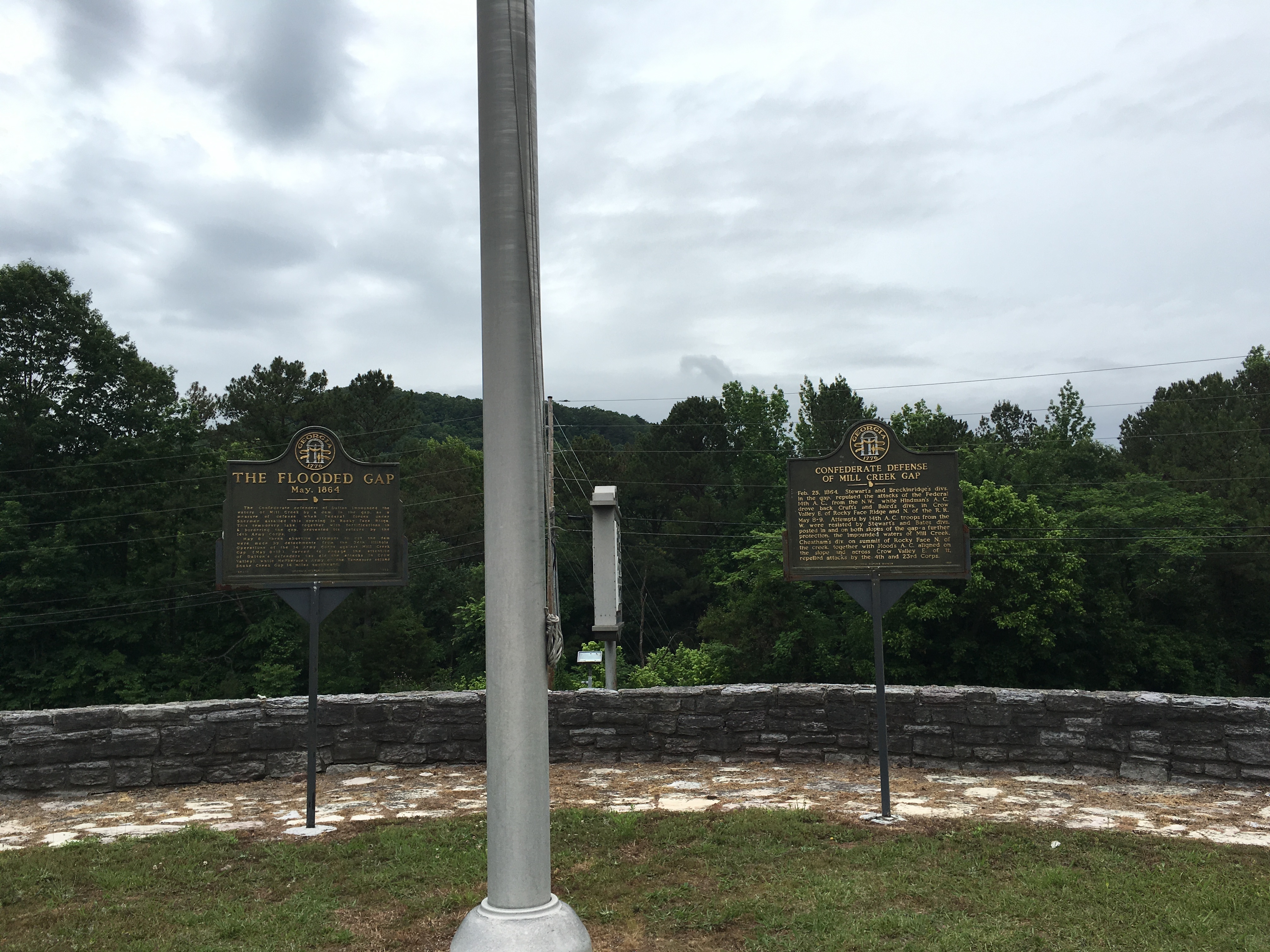
The first stop in the morning was
only a few miles way, following a map the Boys exited the Freeway, and bada boom
bada bing there it was on the left! To freakin' easy!
The Battle of Pine Ridge started
with Confederate General Joseph Johnston entrenching his army on
the long, high mountain of Rocky Face Ridge and eastward across Crow Valley. As Sherman approached, he decided to demonstrate against the position with two
columns while he sent a third one through Snake Creek Gap, to the right, to hit
the Western & Atlantic Railroad at Resaca, Georgia. The two columns engaged the
enemy at Buzzard Roost (Mill Creek Gap) and at Dug Gap. In the meantime, the
third column, under McPherson, passed through Snake Creek Gap and on May 9
advanced to the outskirts of Resaca, where it found Confederates entrenched.
Fearing defeat, McPherson pulled his column back to Snake Creek Gap. On May 10,
Sherman decided to take most of his men and join McPherson to take Resaca. The
next morning, as he discovered Sherman's army withdrawing from their positions
in front of Rocky Face Ridge, Johnston retired south towards Resaca.


The Pine Ridge Marker was on a bluff over looking the road. It was easy to see
how Johnston straddled the ridge. Walking around, Mike saw that a "fort" was
further up the Hill.
w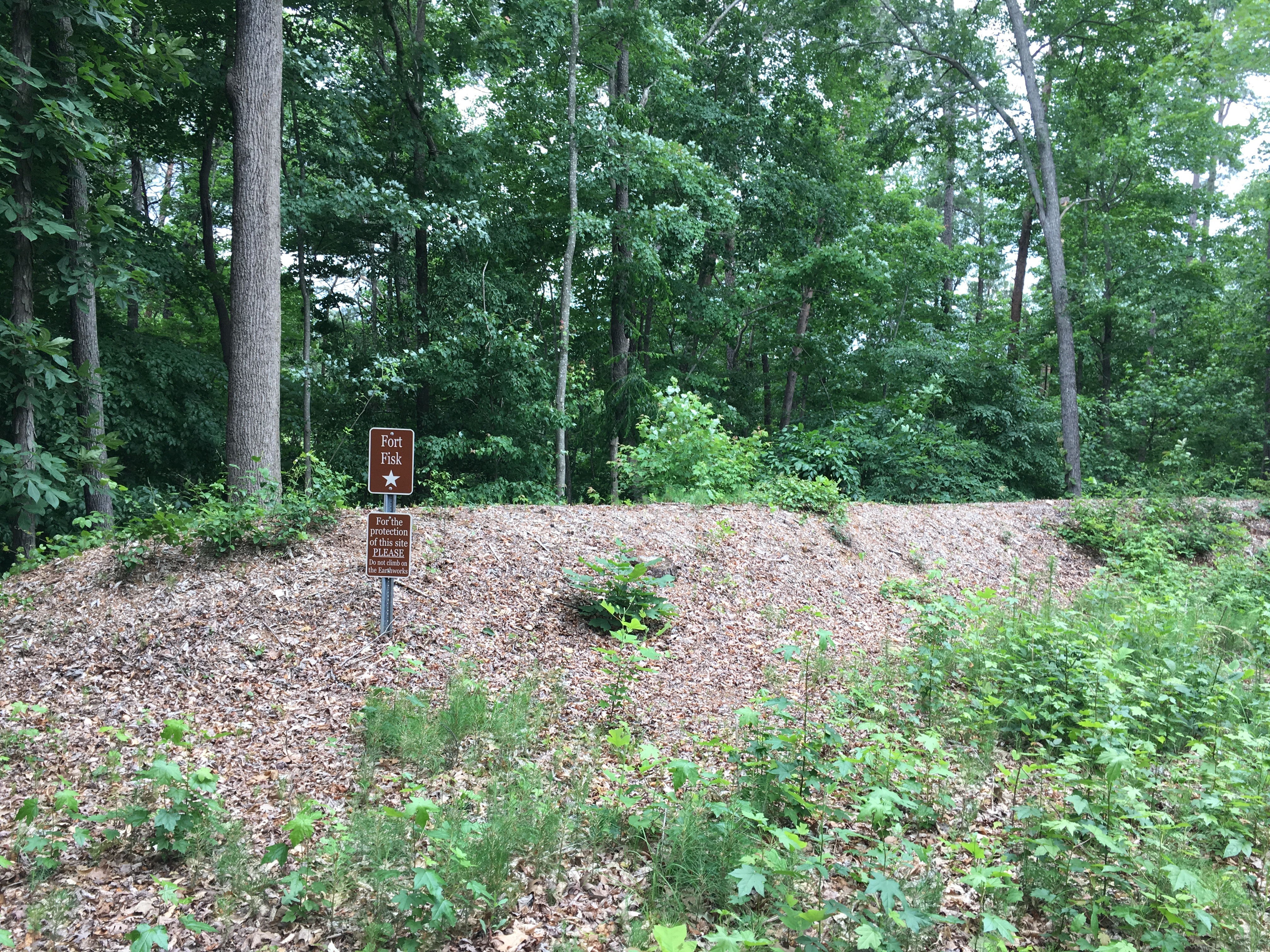
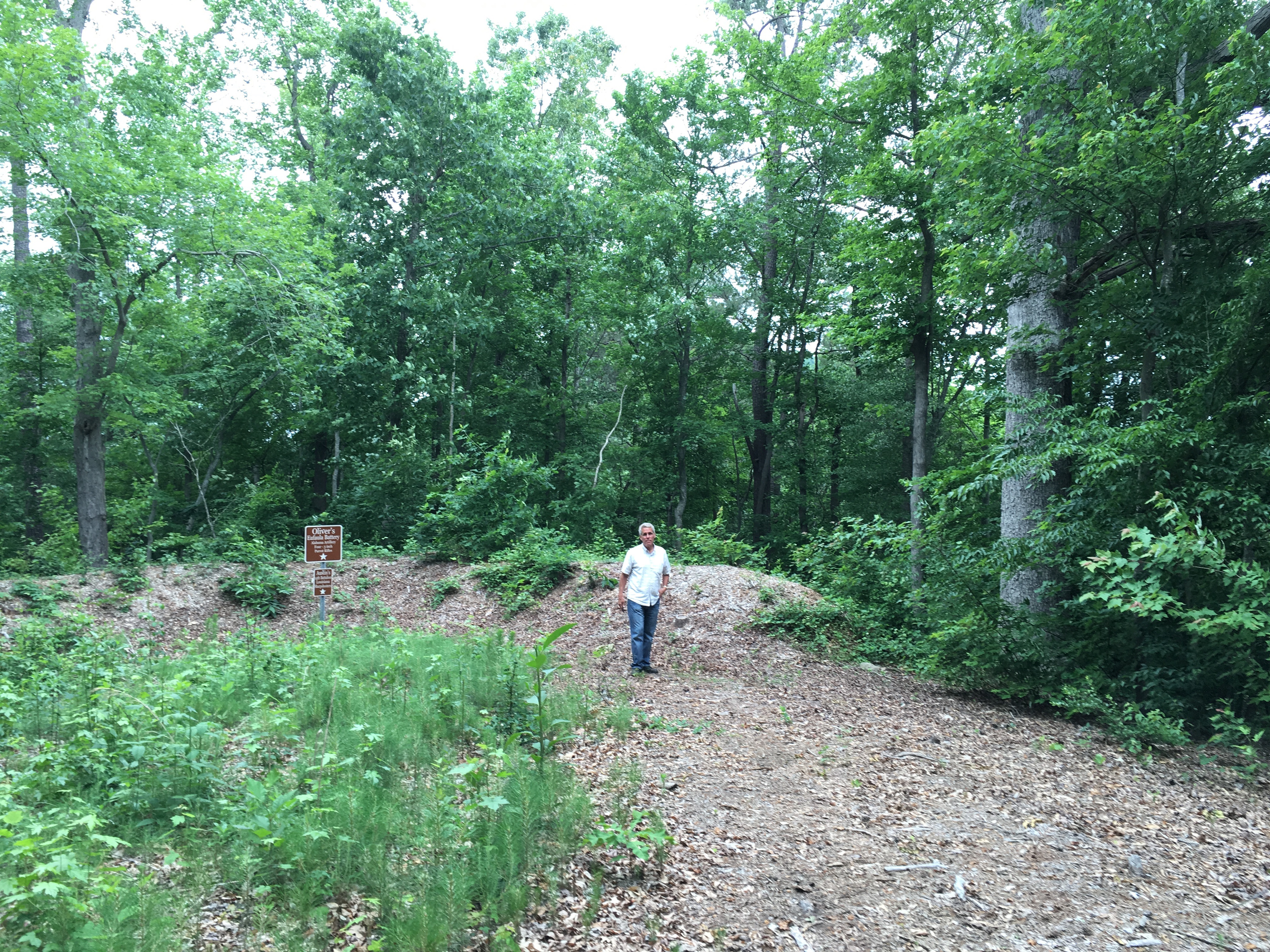
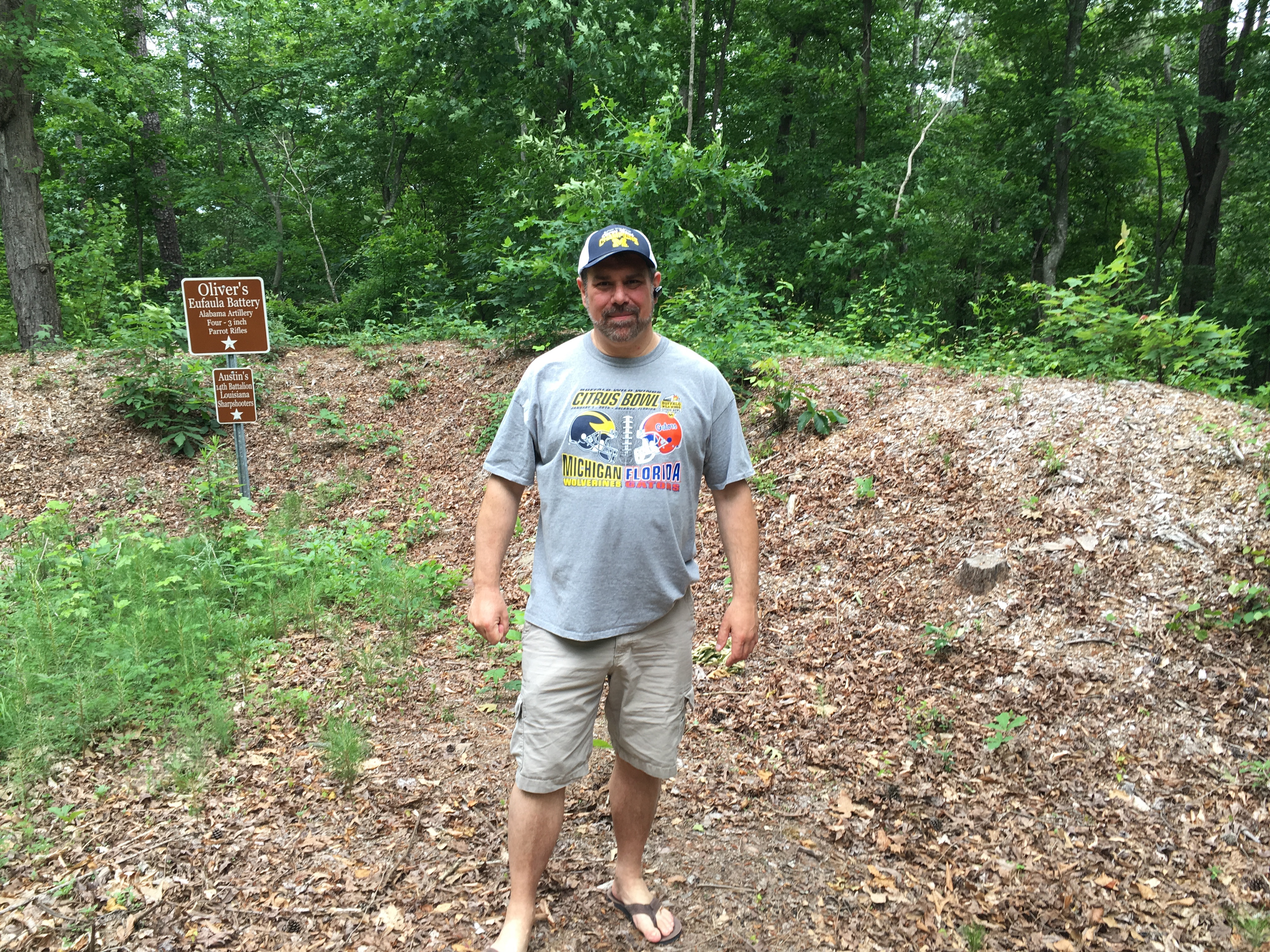
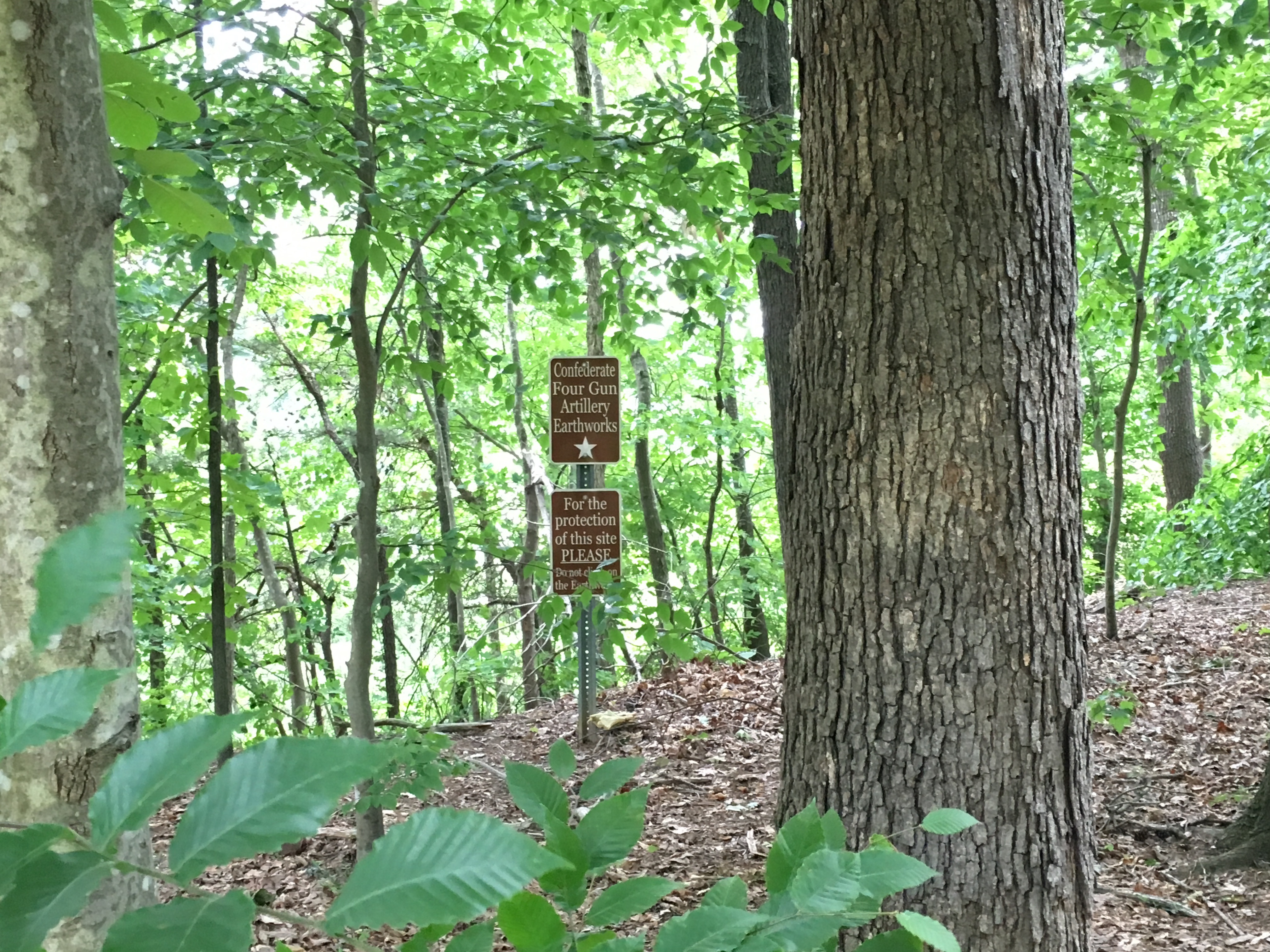
"Fort Walker" is one of hundreds of forts that both sides would build overnight,
mostly just enclosed trenches, they were effective to protect the men in them
from the relentless lead that was in the air during an engagement. At 15 minutes
wandering around, the Boys headed for Resaca!
Stop 2: Battle of Resaca (May 13–15)
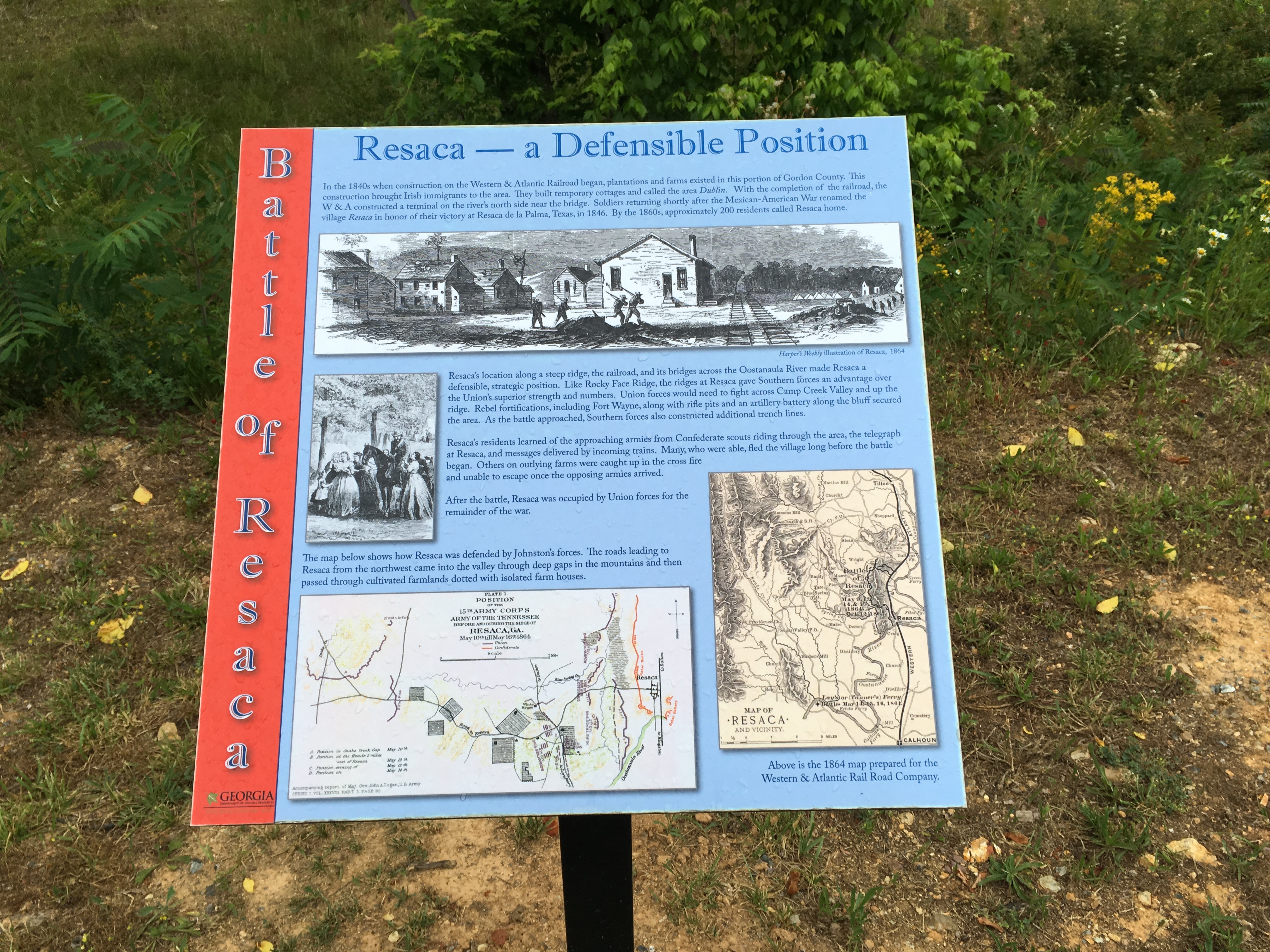
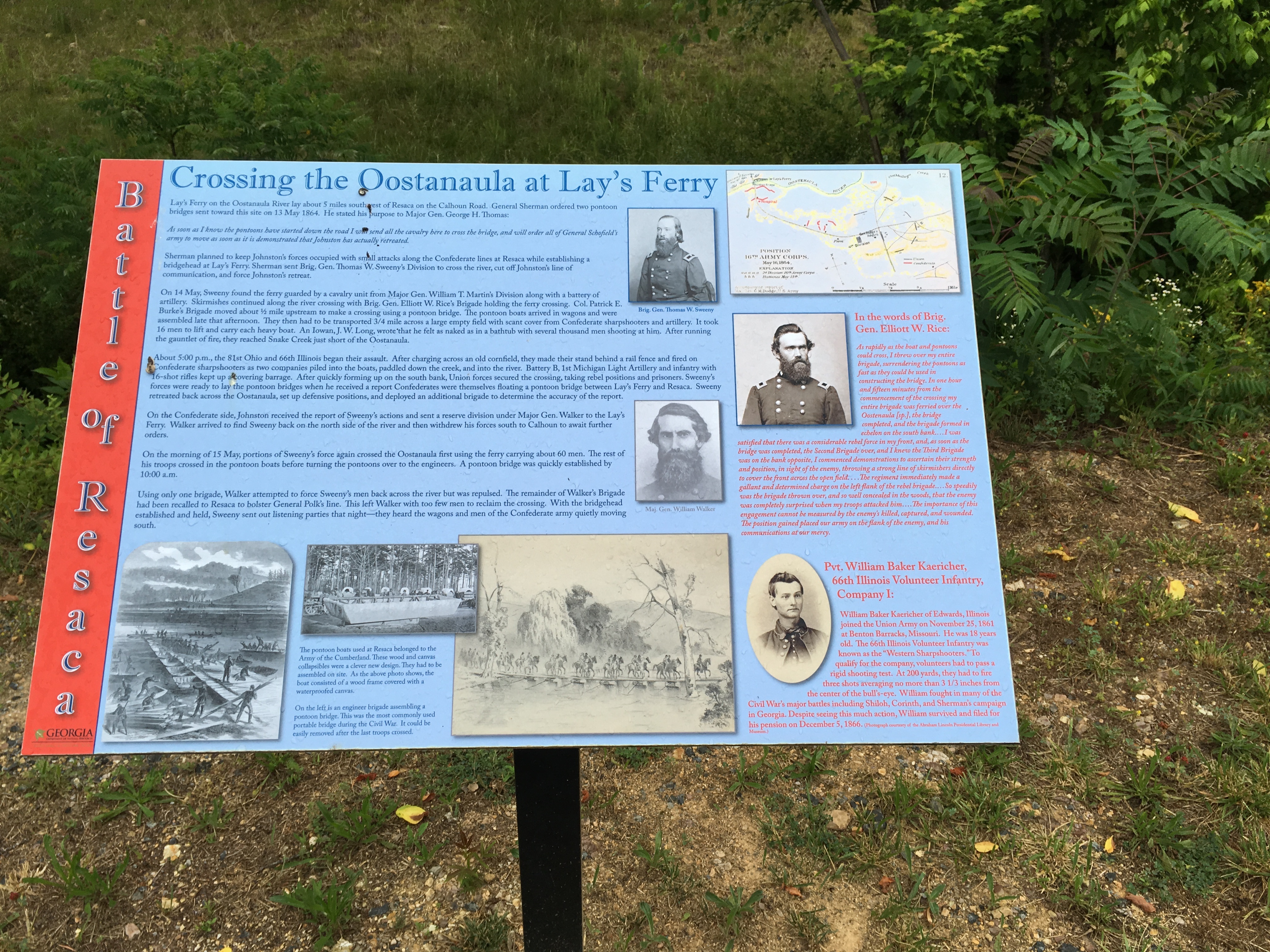
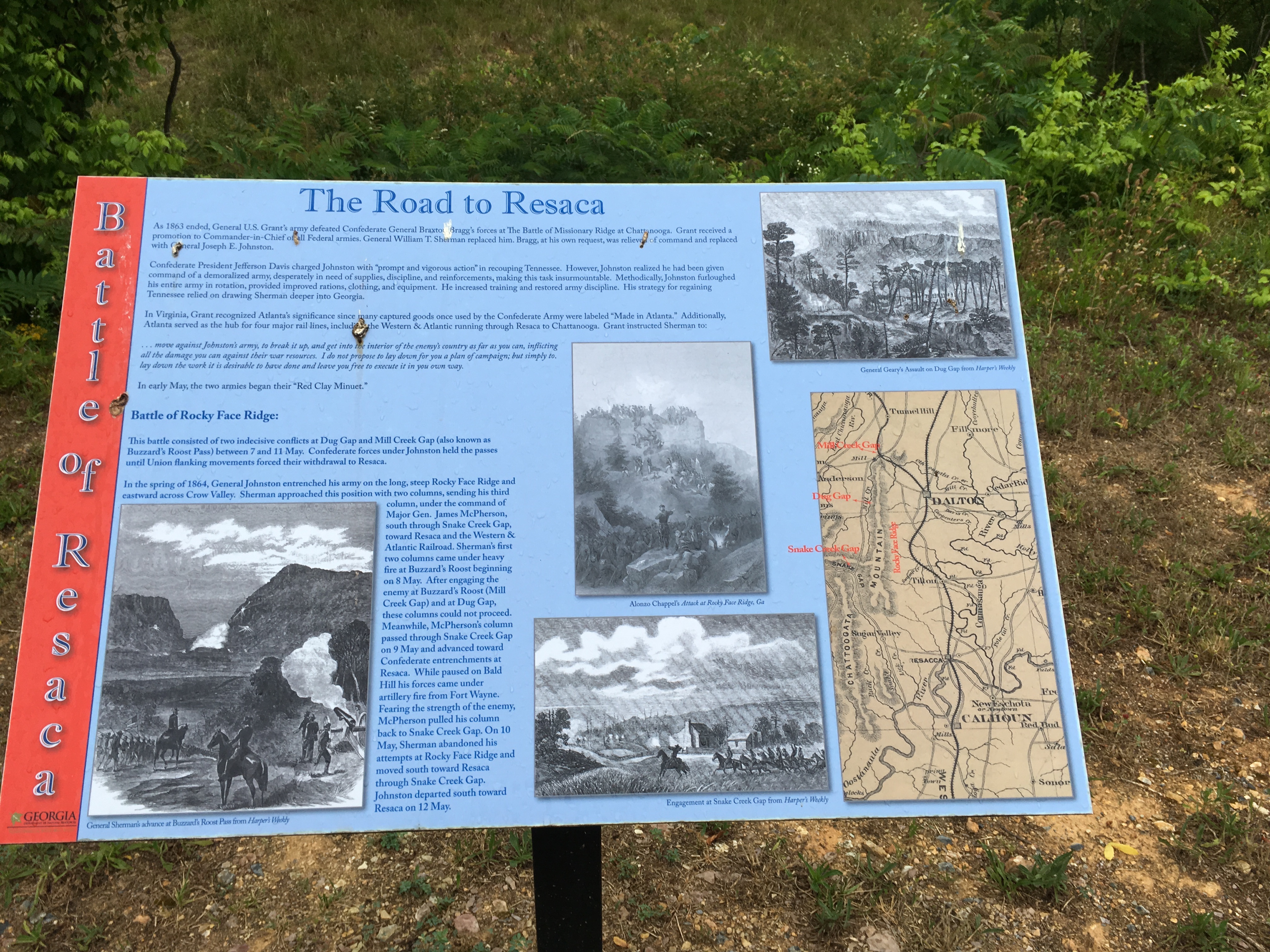
Mike and Bone were lucky again, Resaca National Battlefield is right off of
South I-75, Rescaca, unlike Pine Ridge is a more than a limited Historical
Marker, it is a full National Battlefield with markers around the battle. Mike
and Bone walked the little tour with the forboding of rain in the air.
Resaca was were
Union troops tested the Confederate lines to pinpoint their
whereabouts. Full scale fighting erupted on May 14, and the Union troops were
generally repulsed except on Johnston's right flank, where Sherman did not fully
exploit his advantage. On May 15, the battle continued with no advantage to
either side until Sherman sent a force across the Oostanula River at Lay's
Ferry, towards Johnston's railroad supply line. Unable to halt this Union
movement, Johnston was forced to retire.
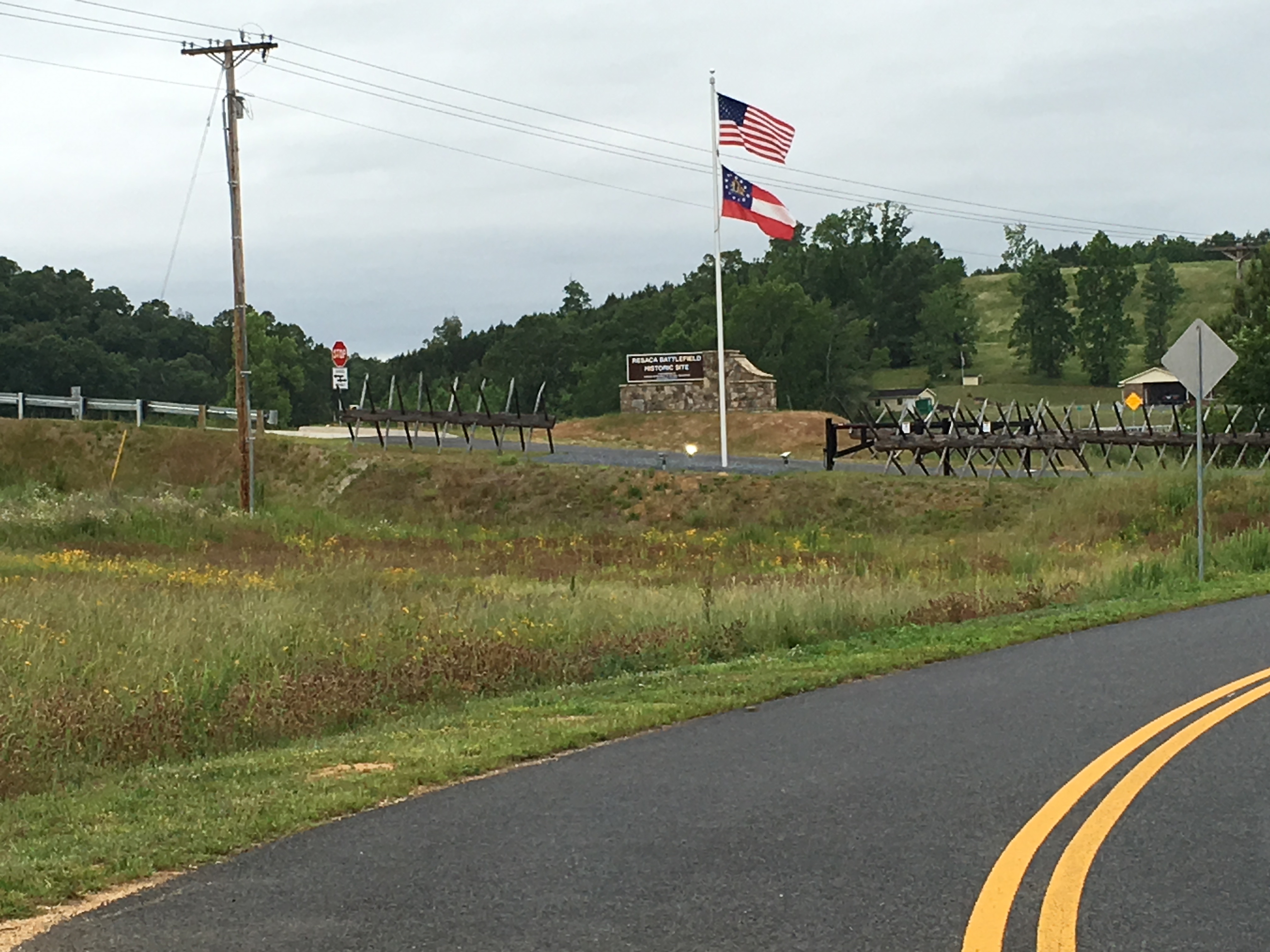
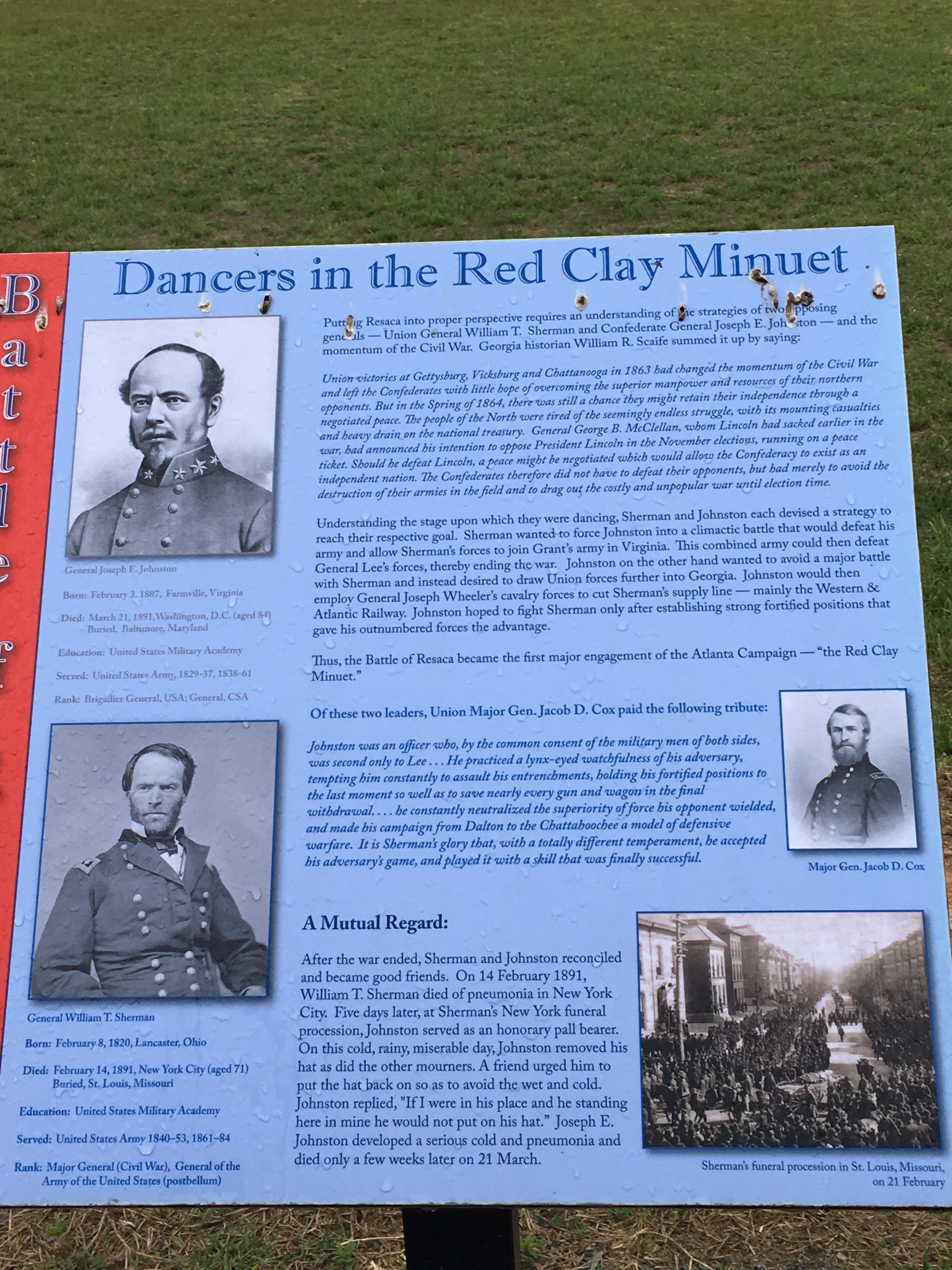
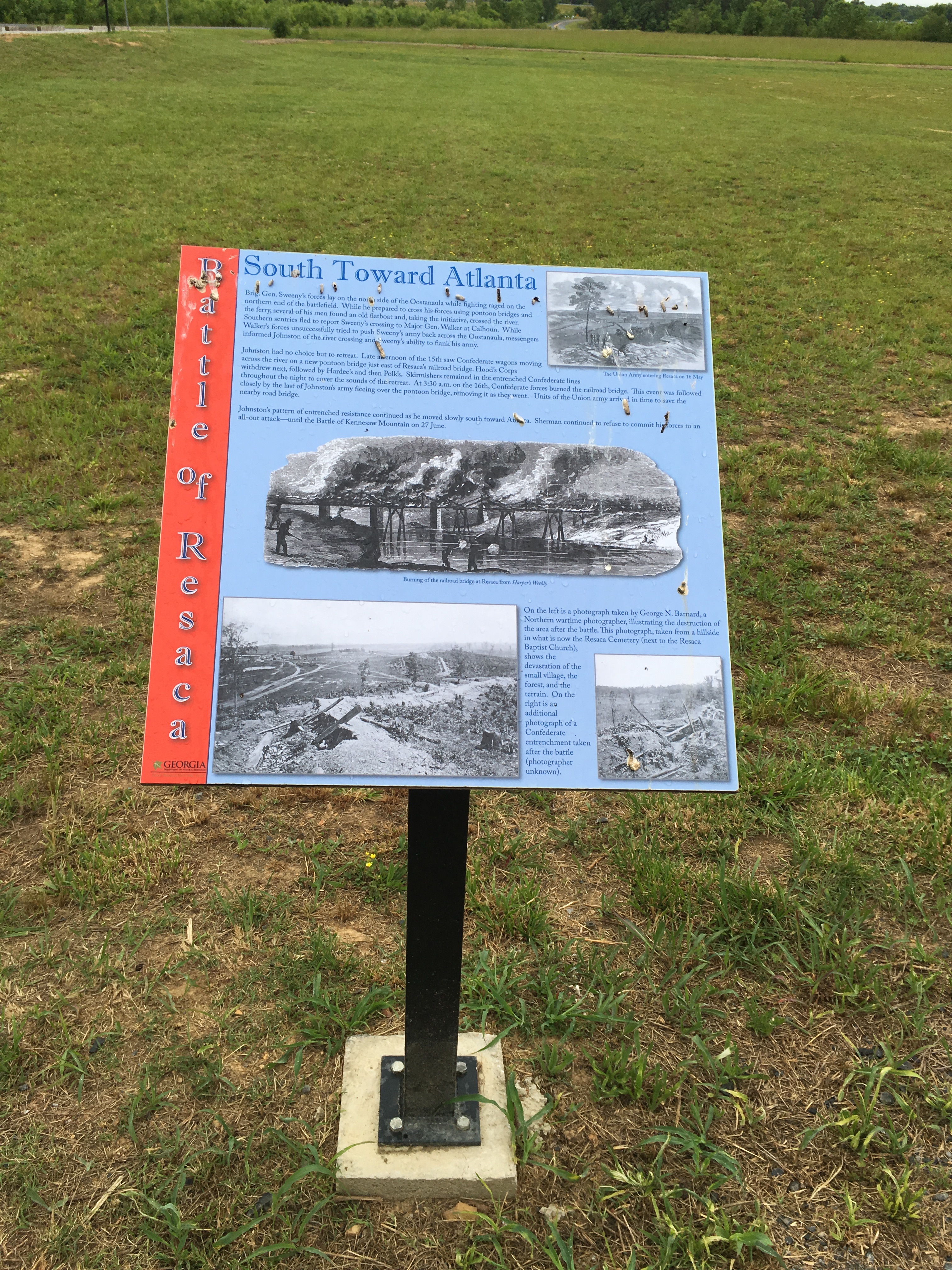
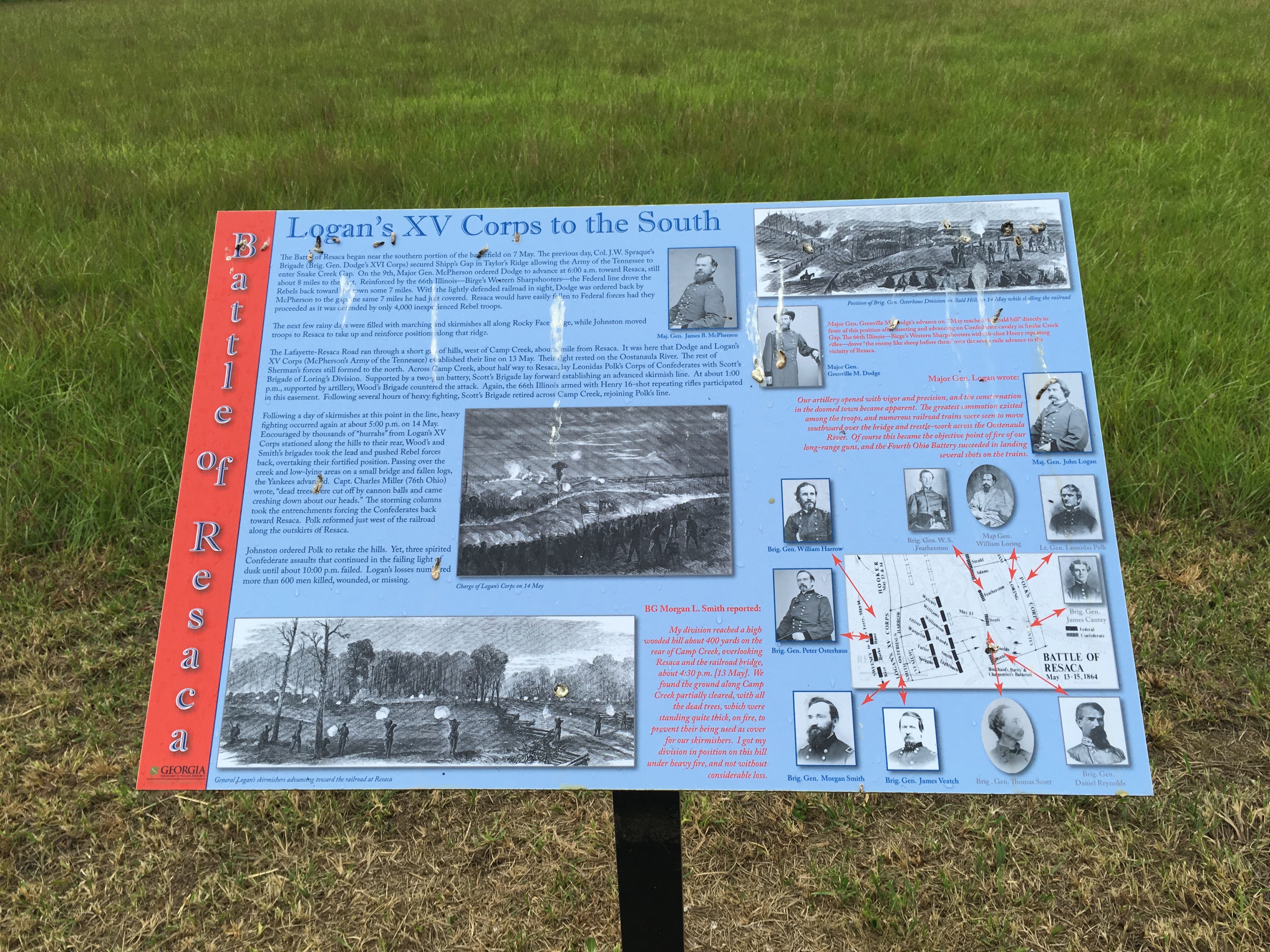
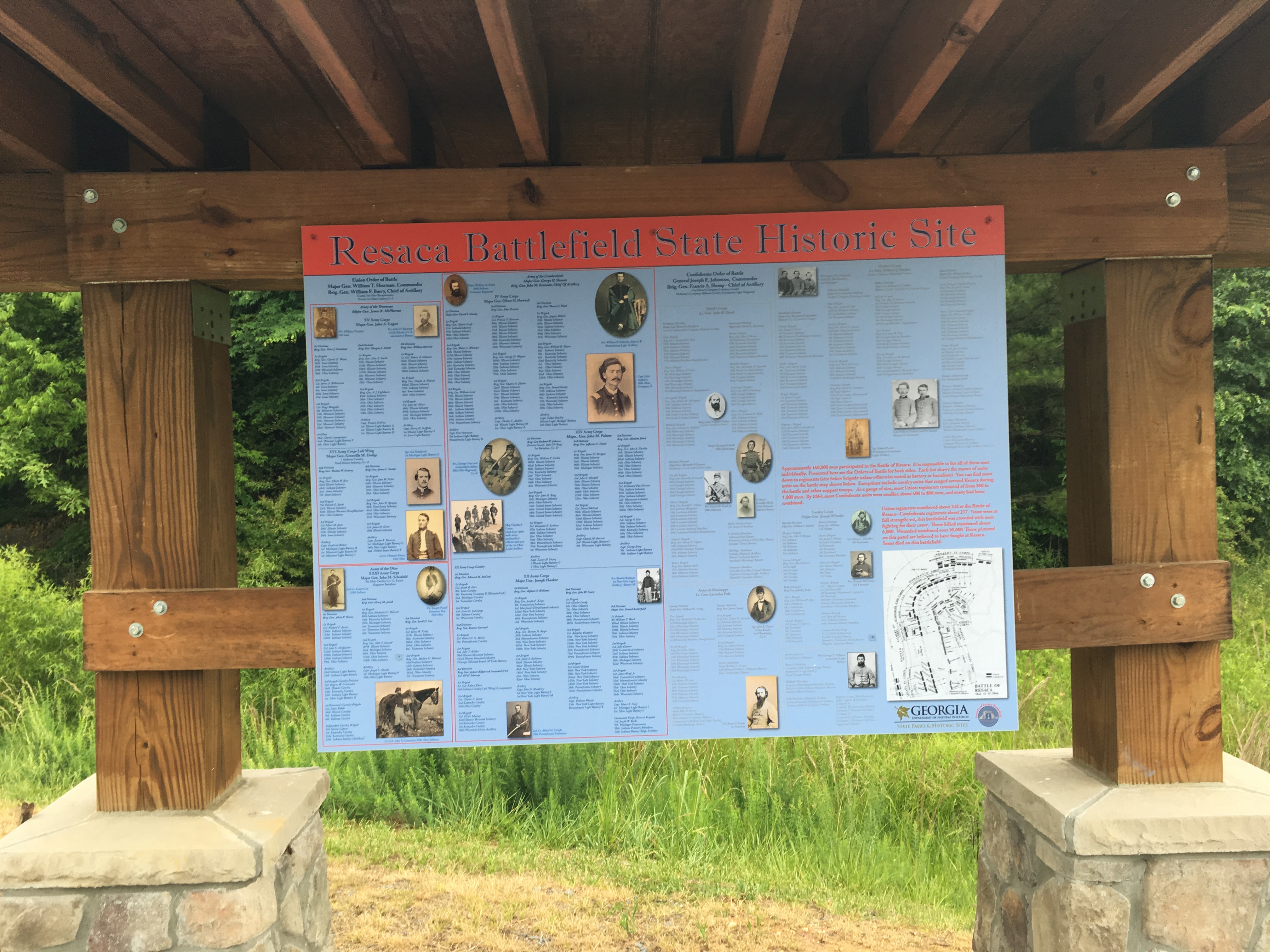
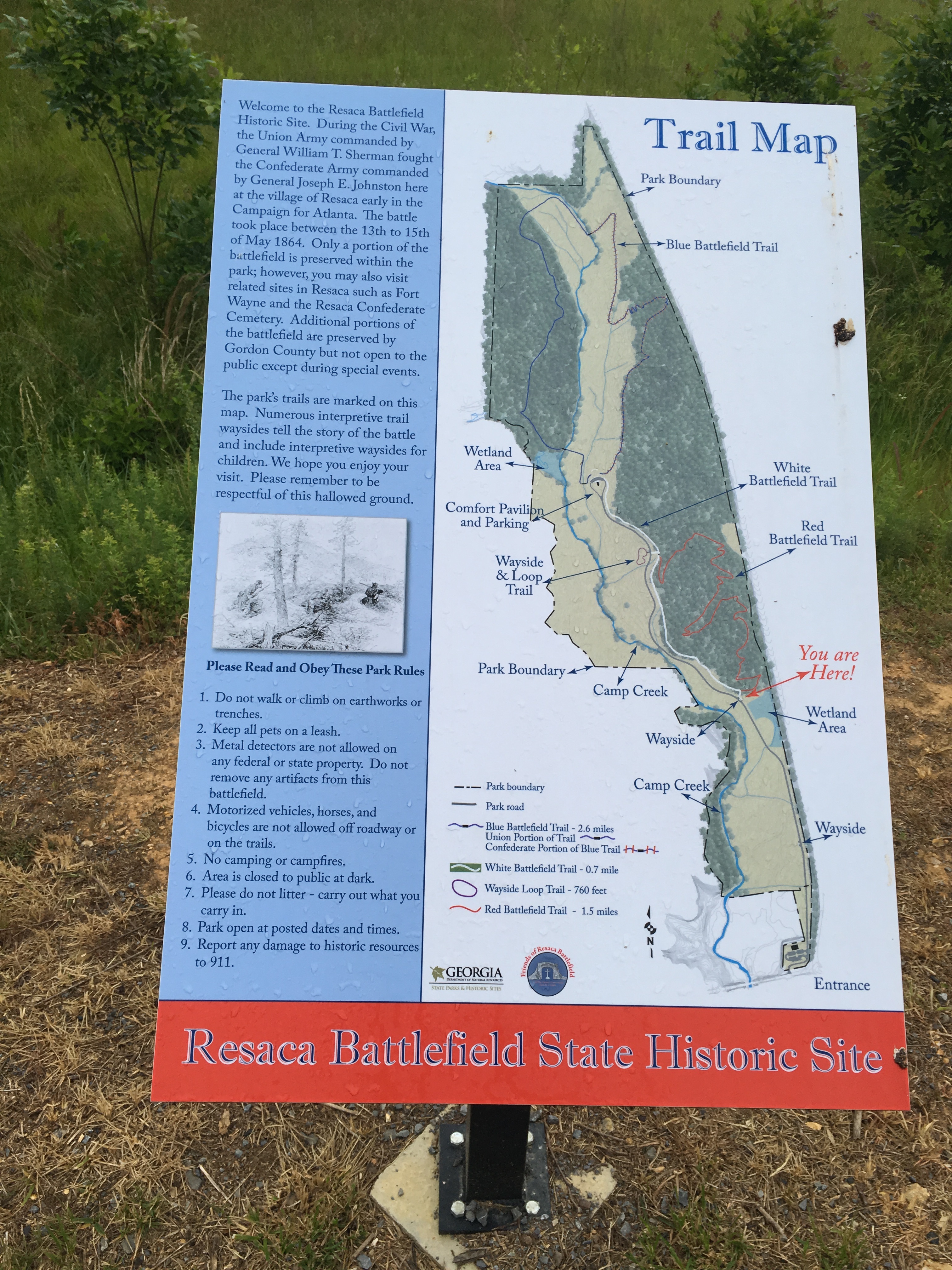
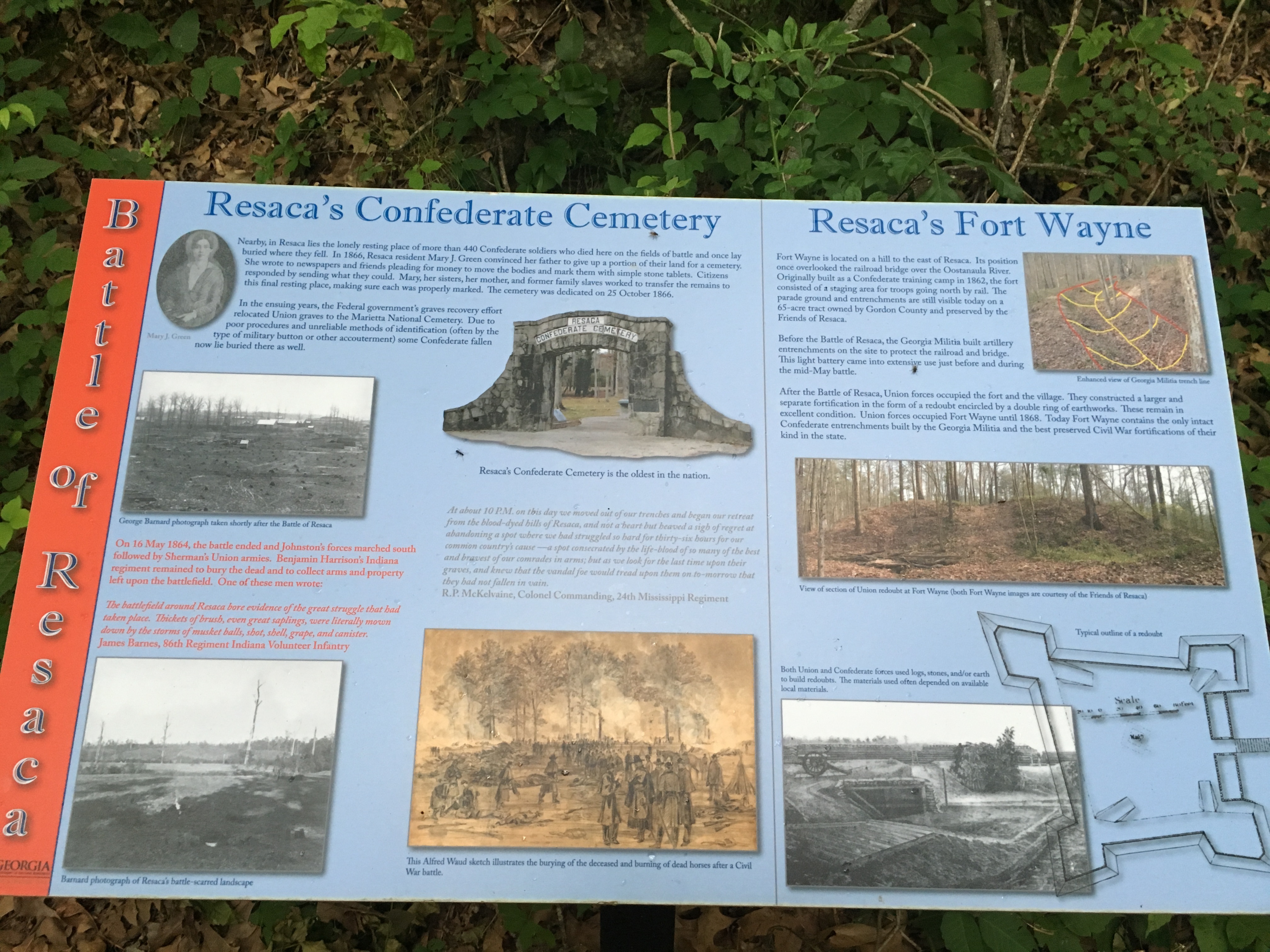
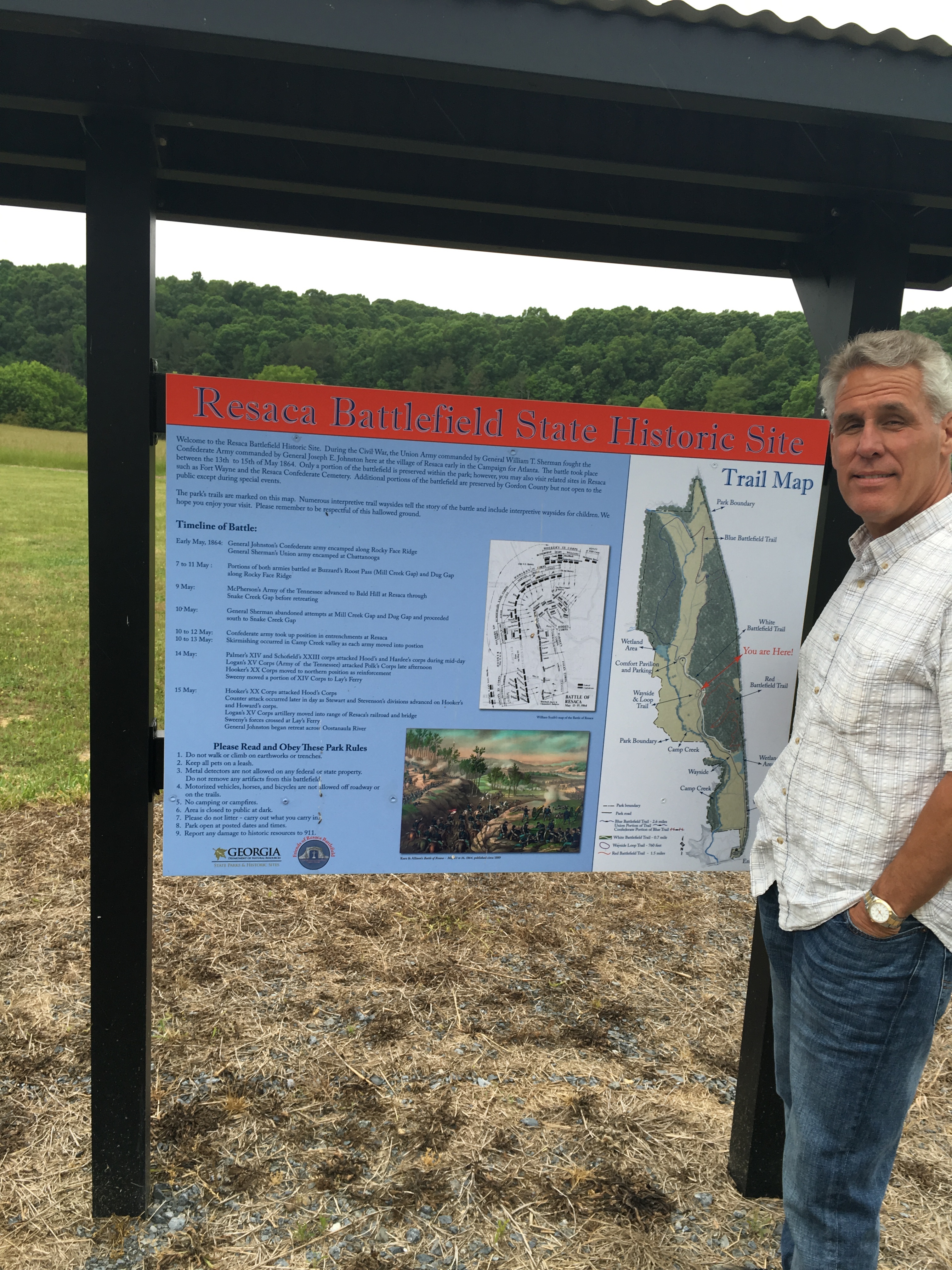
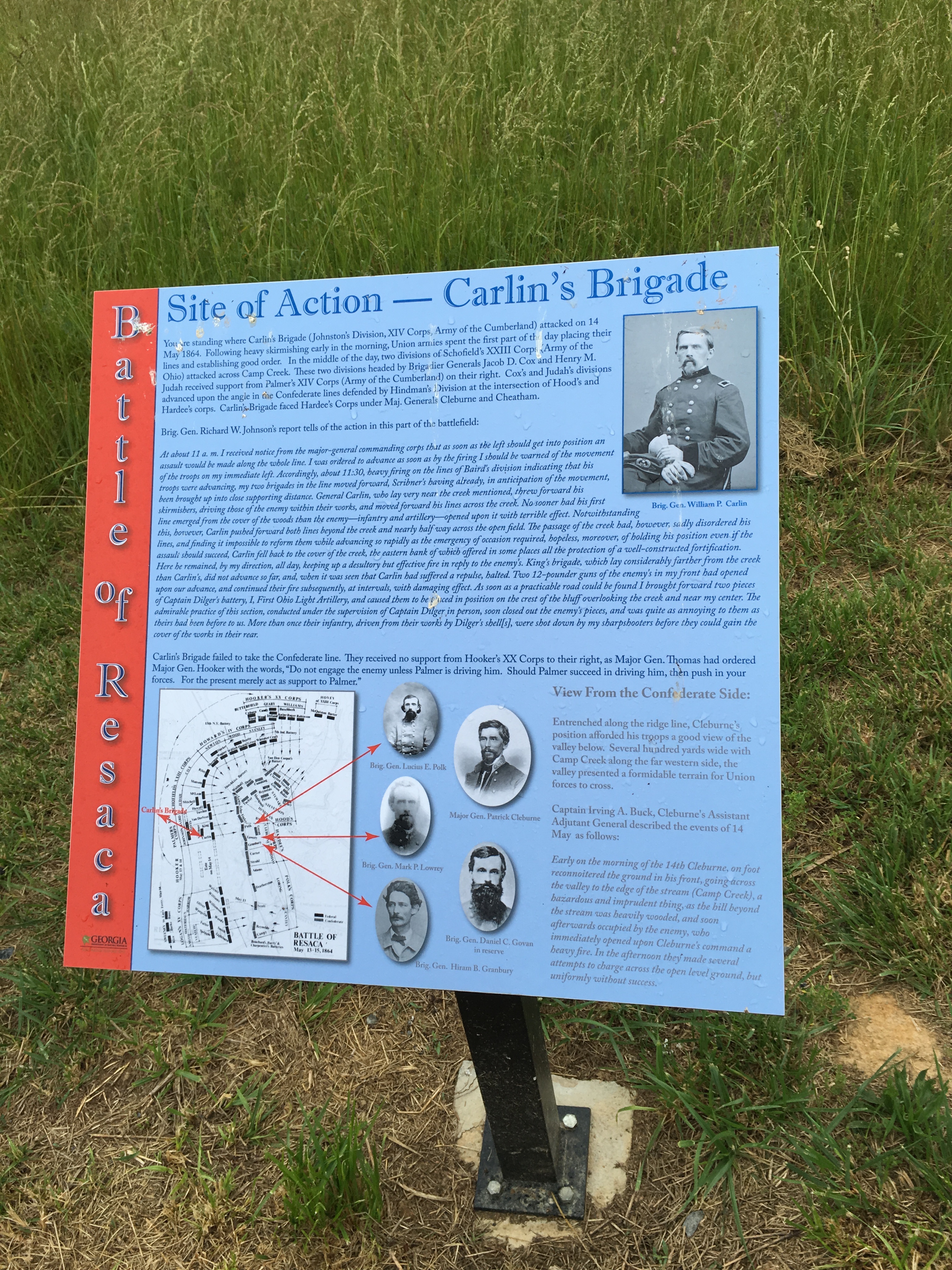


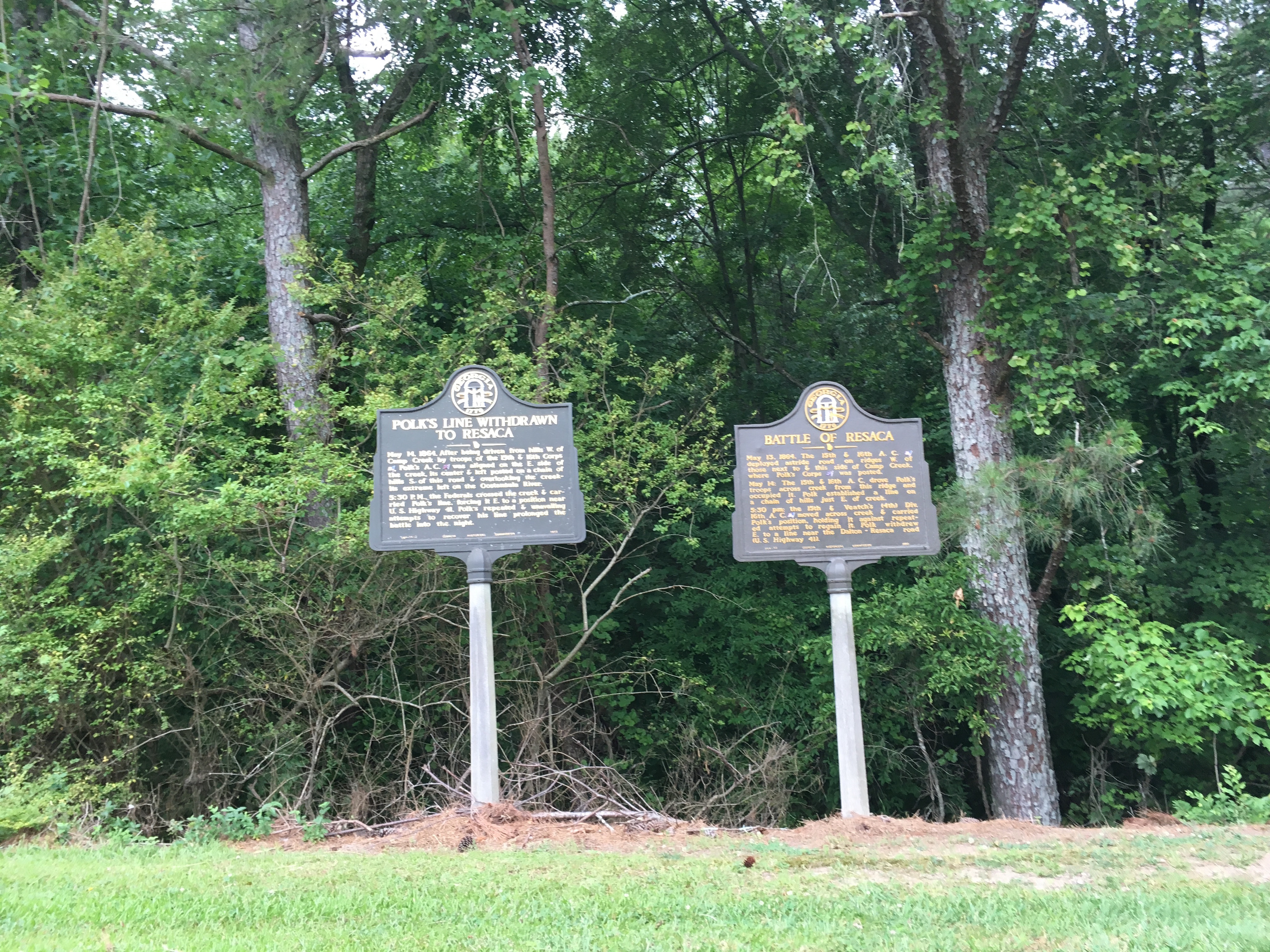
Mike and Bone walked the Battlefiled for about a half an hour, reading all
the various movements of Sherman and Johnston, being buried in the past, they
decided to pay their respects to those paid their lives in this Battle.
Resting in Relative Peace: The Resaca Confederate Cemetery
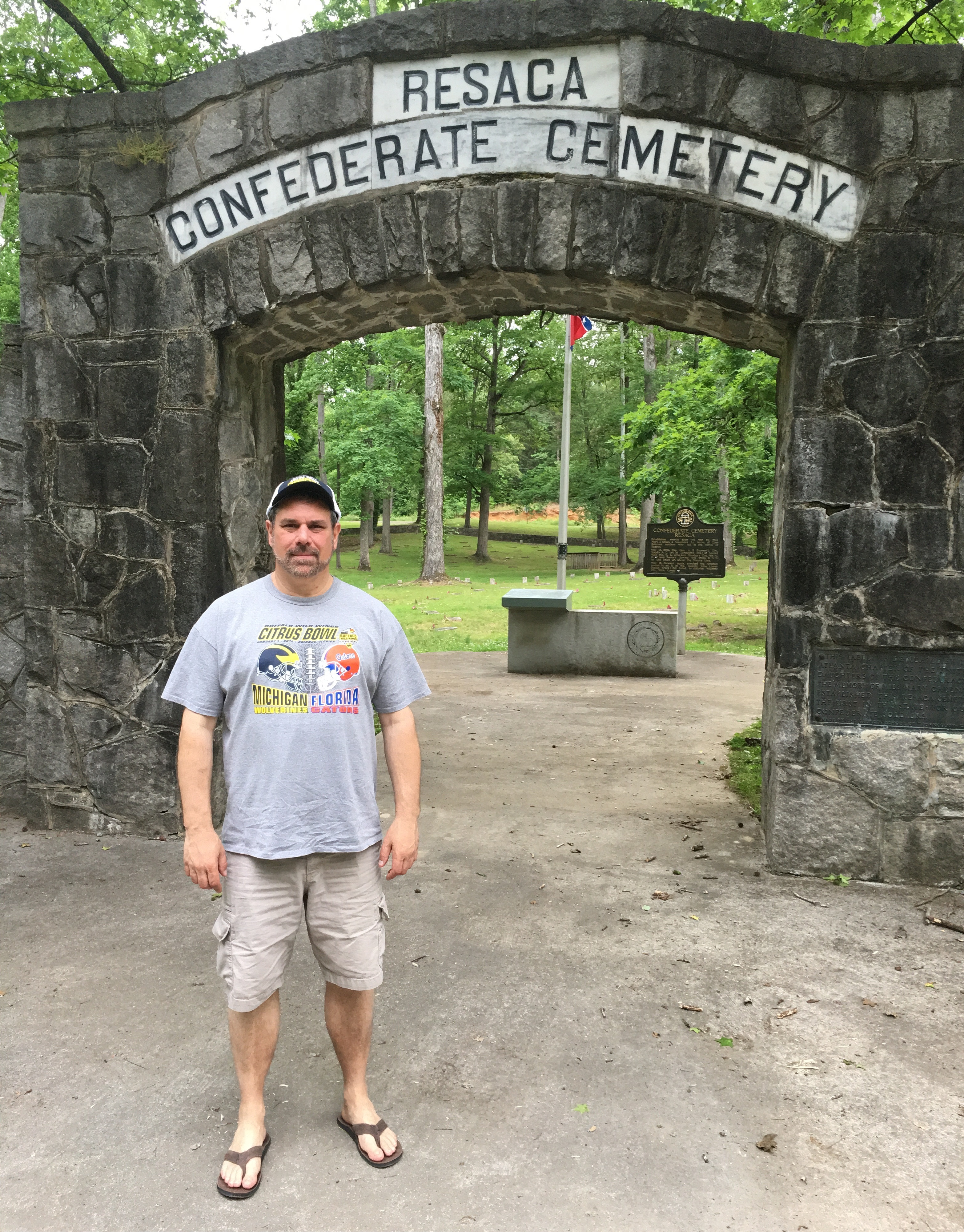
One of the cool and poignant things the Boys saw in Resaca was the Confederate
Cemetery. It is the burial place of over 450 Confederate soldiers who died
during the Atlanta Campaign. It is dedicated for the soldiers that fought in the
Battle of Resaca. From the two days of battle at Resaca there are only three
graves where the death date is listed as May 15, 1864. The remaining graves are
listed as May 14, 1864. Some of the soldiers were identified but there are still
424 graves marked "unknown". The cemetery was based on the generosity of a local
family, the Greens. After the battle, the Green family returned to their
plantation and the sight that met them there was almost more than they could
bear. The bodies of confederate soldiers were buried in crude makeshift graves
all across the yard. Compelled by a sense of respect to those who had fallen in
action, Mary J. Green and her sister began collecting the bodies to bury
properly. Though poverty was rampant, the Green daughters wrote friends asking
for any amount money they could give. Col. John Green gave his daughters 2.5
acres of land for use as a cemetery for these soldiers. With the money collected
and the land provided, the Green daughters and their mother began work on what
we now call the Resaca Confederate Cemetery. The Resaca Confederate Cemetery was
founded on October 25, 1866. Ironically, this cemetery and one in Winchester,
Virginia were both dedicated on the same day, with each group thinking that they
were the first confederate cemetery.
Cemetery Sponsor: Mary Jane Green
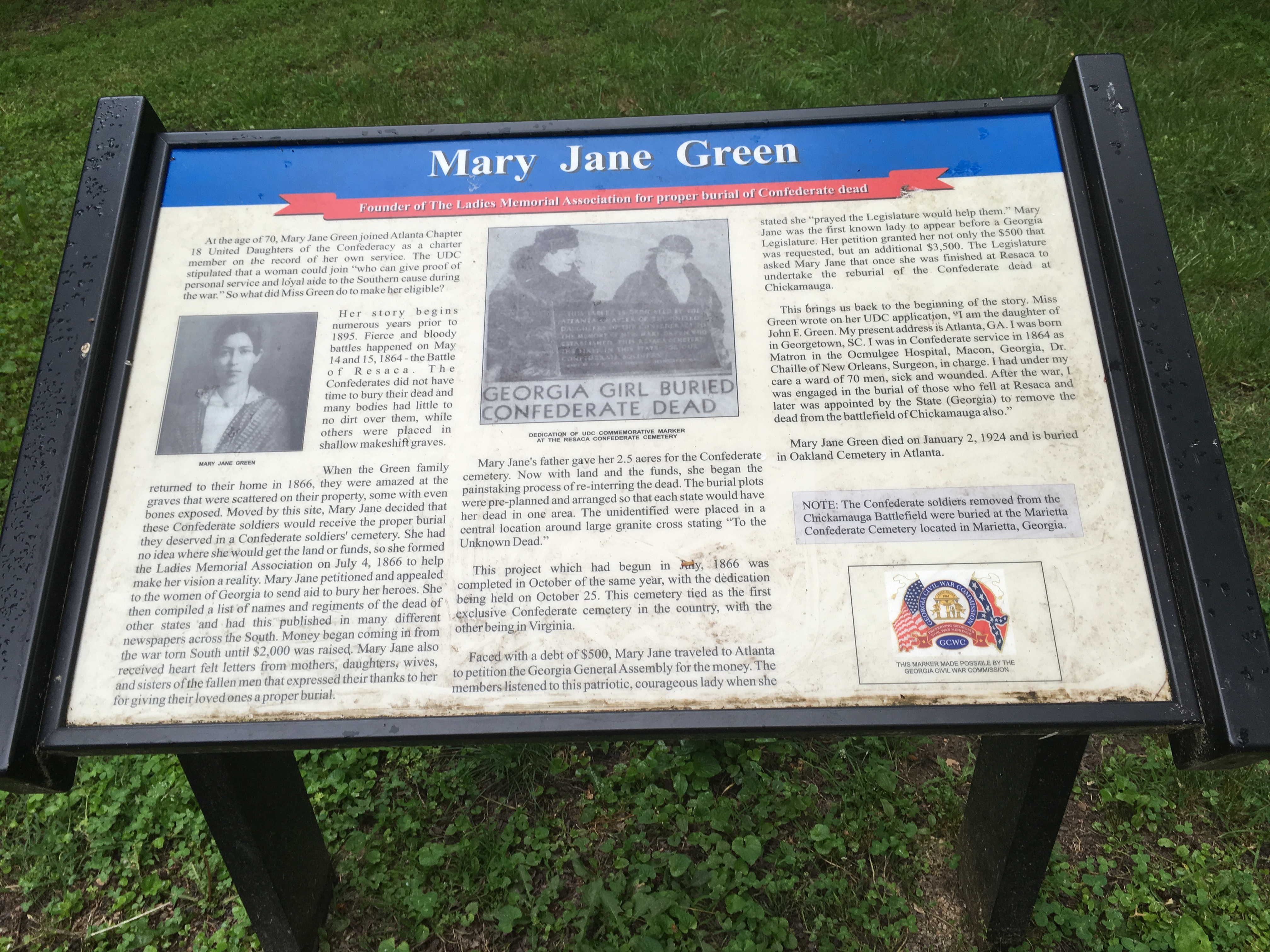
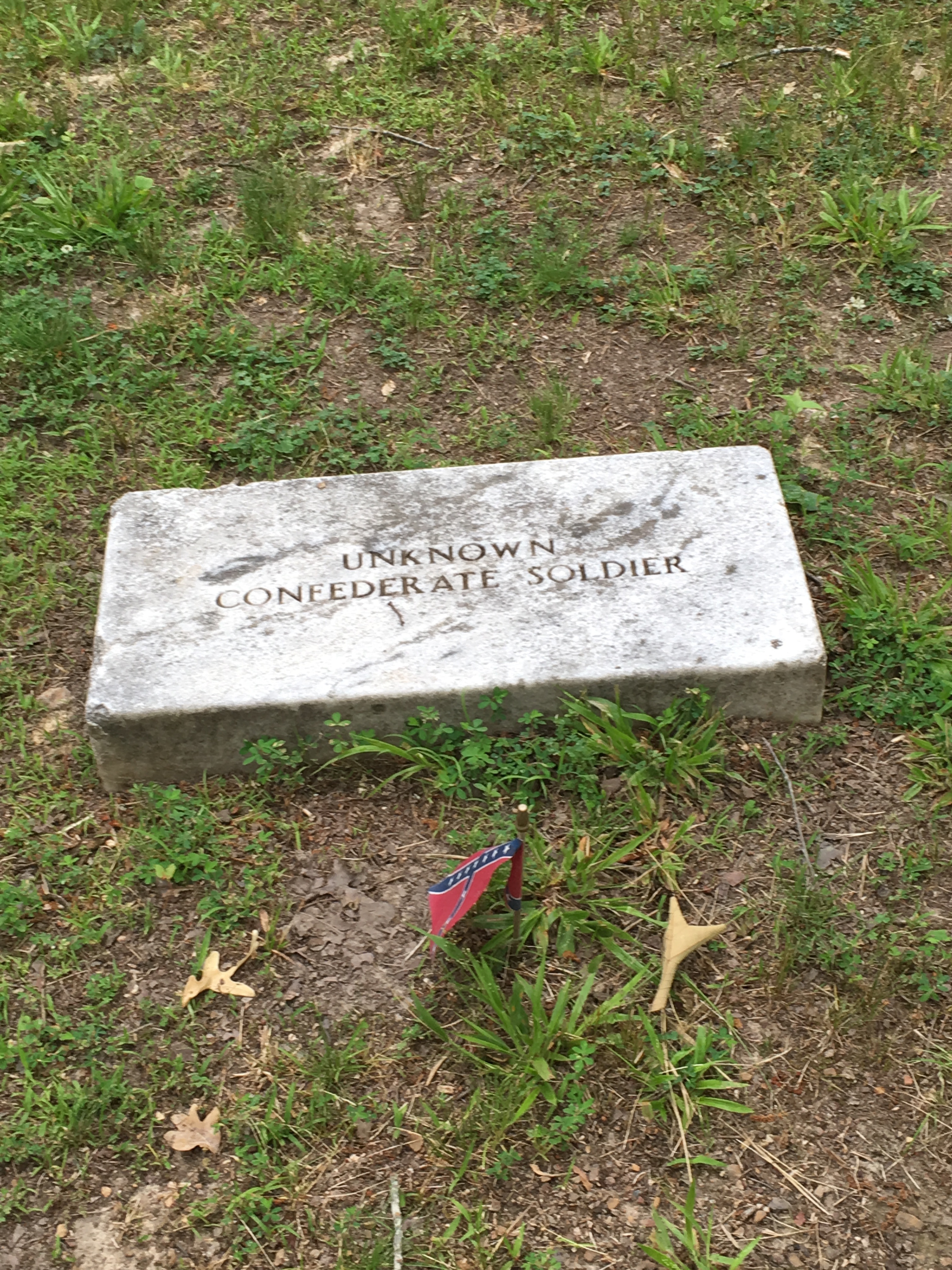
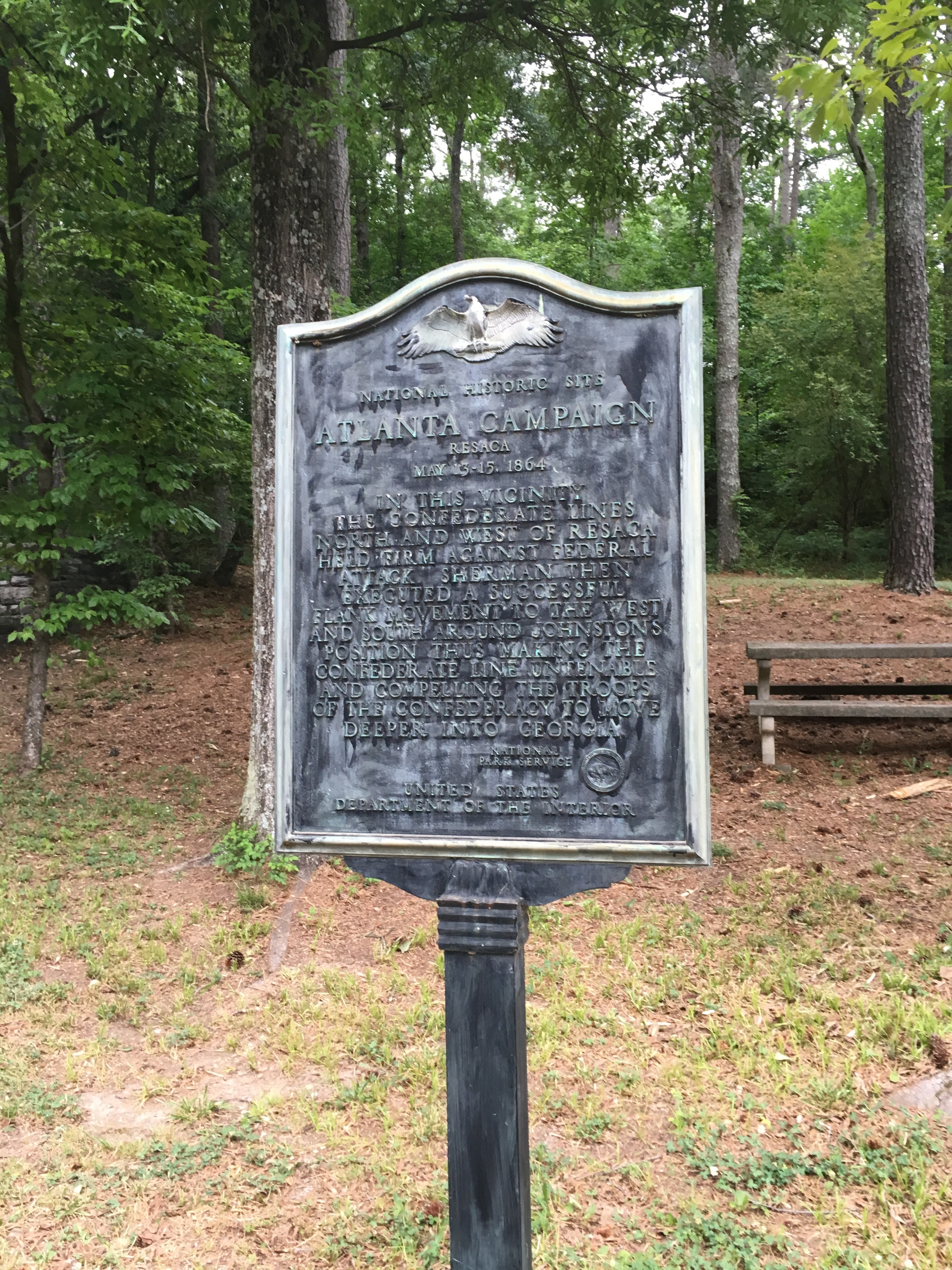
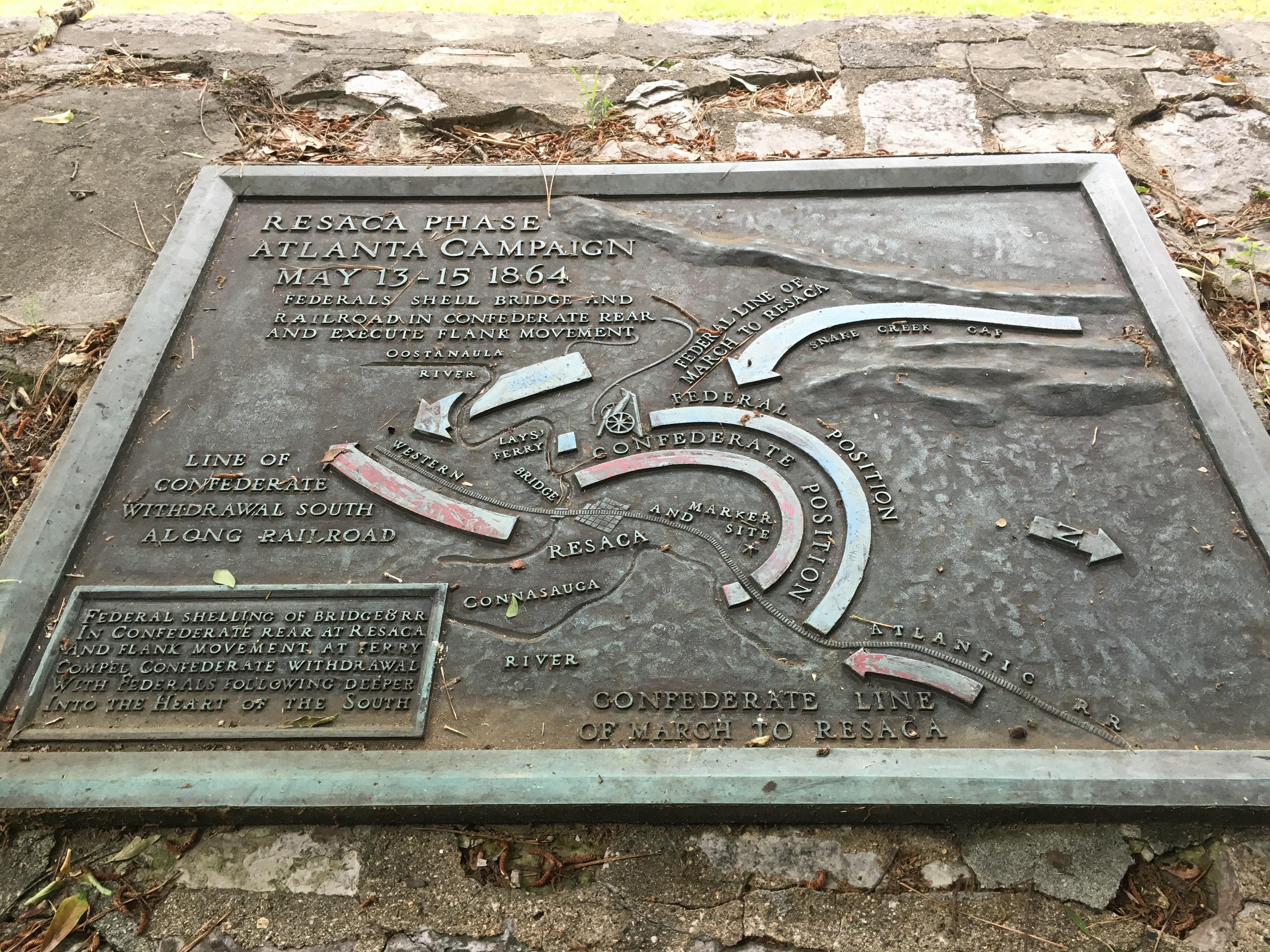
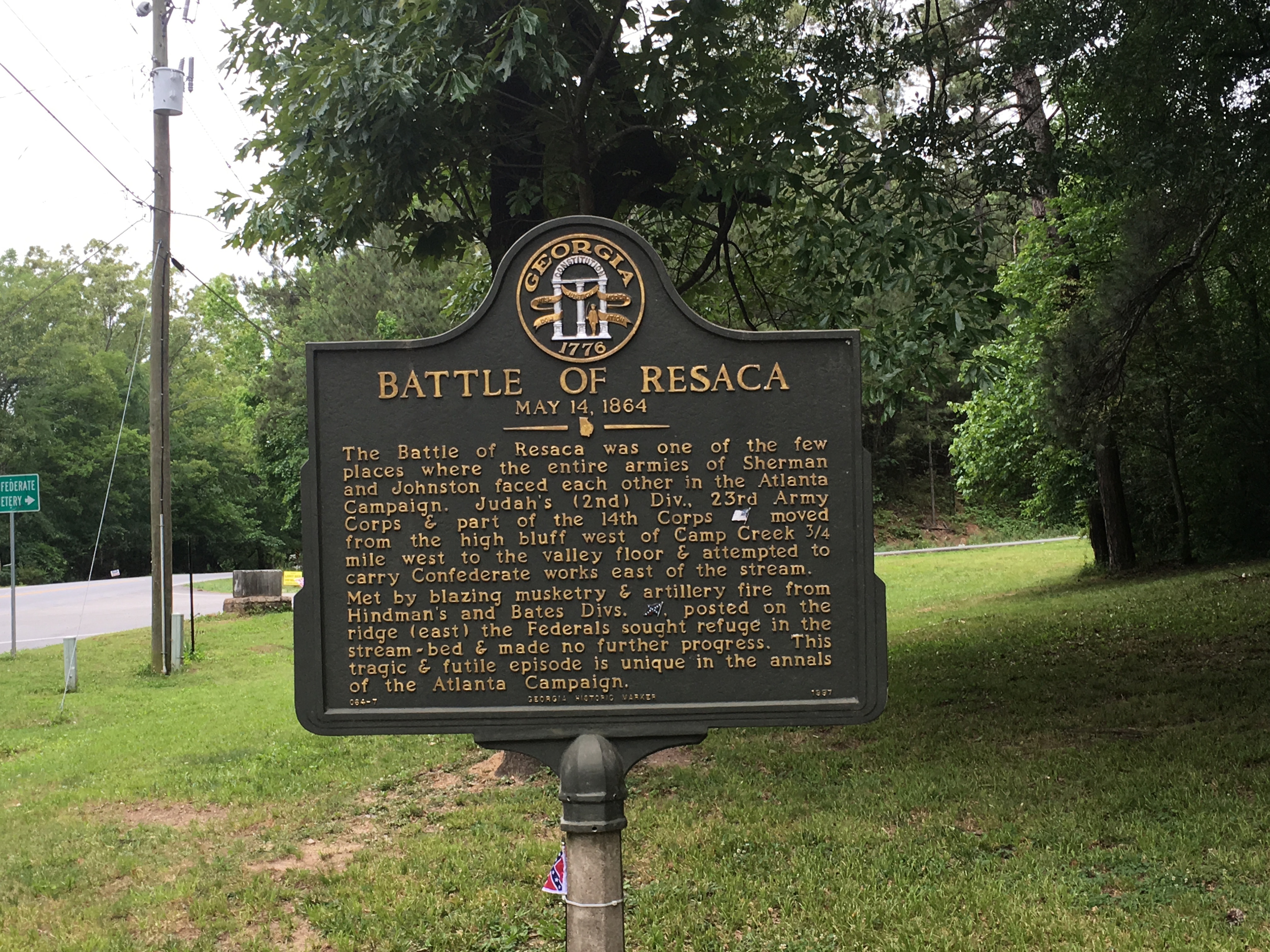
Mike, Checking out a Confederate Marker
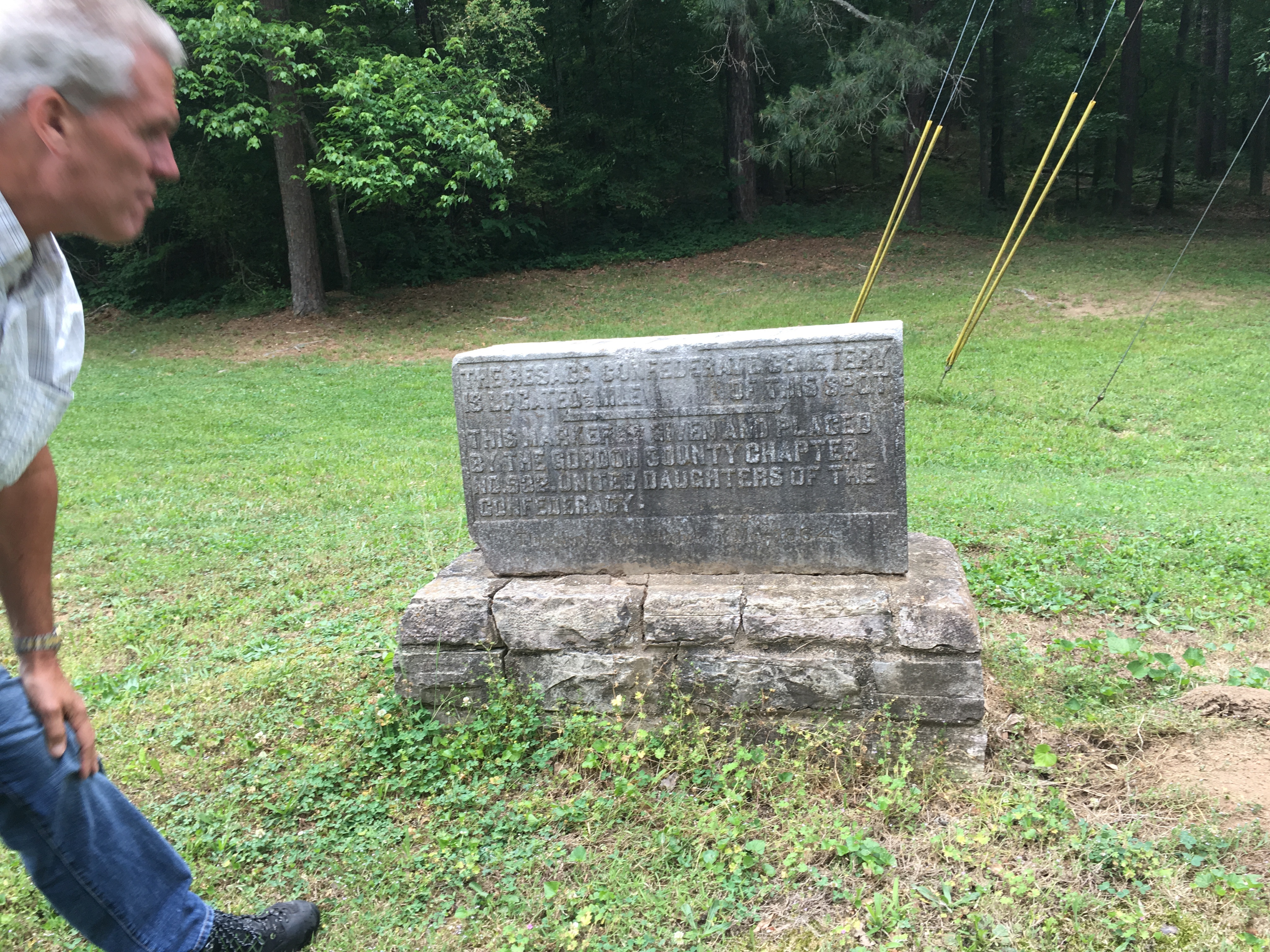
Stop 3: "There Ain't No Adair There" (May 17)
Hitting Highway 41 south (a road that Mike and Bone would crisscross with I-75
both days) which Sherman chased and flanked Johnston for the whole campaign, the
skies finally opened and a deluge came down. Driving through the little Town of
Adair, Mike and Bone stopped for lunch at a quaint little Country Inn. The stop
was useless on two accounts. The proprietors had already stopped serving lunch,
and they gave the Boys the wrong information on where to find the Adair markers.
It turned out they were north (about 1/4 mile from the Country Inn),
unfortunately until 40 minutes down 41 when they figured it out!
However they read that
Johnston's army retreated southward from Resaca while Sherman pursued. Failing to find a
good defensive position south of Calhoun, Johnston continued to Adairsville
while the Confederate cavalry fought a skillful rearguard action. On May 17,
Howard's IV Corps ran into entrenched infantry of Hardee's corps, while
advancing about two miles north of Adairsville (close to the Country Inn). Three Union divisions
prepared for battle, but Union General George "Rock of Chicamauga" Thomas
halted them because of the approach of darkness. Sherman then concentrated his
men in the Adairsville area to attack Johnston the next day. Johnston had
originally expected to find a valley at Adairsville of suitable width to deploy
his men and anchor his line with the flanks on hills, but the valley was too
wide, so Johnston disengaged and withdrew further south on Highway 41.
Driving down Highway 41 The Boys took a detour from the ATL Campaign to check
out another cool historical site, the Etowah Indian Mounds!
Being Honest Injuns @ Etowah!
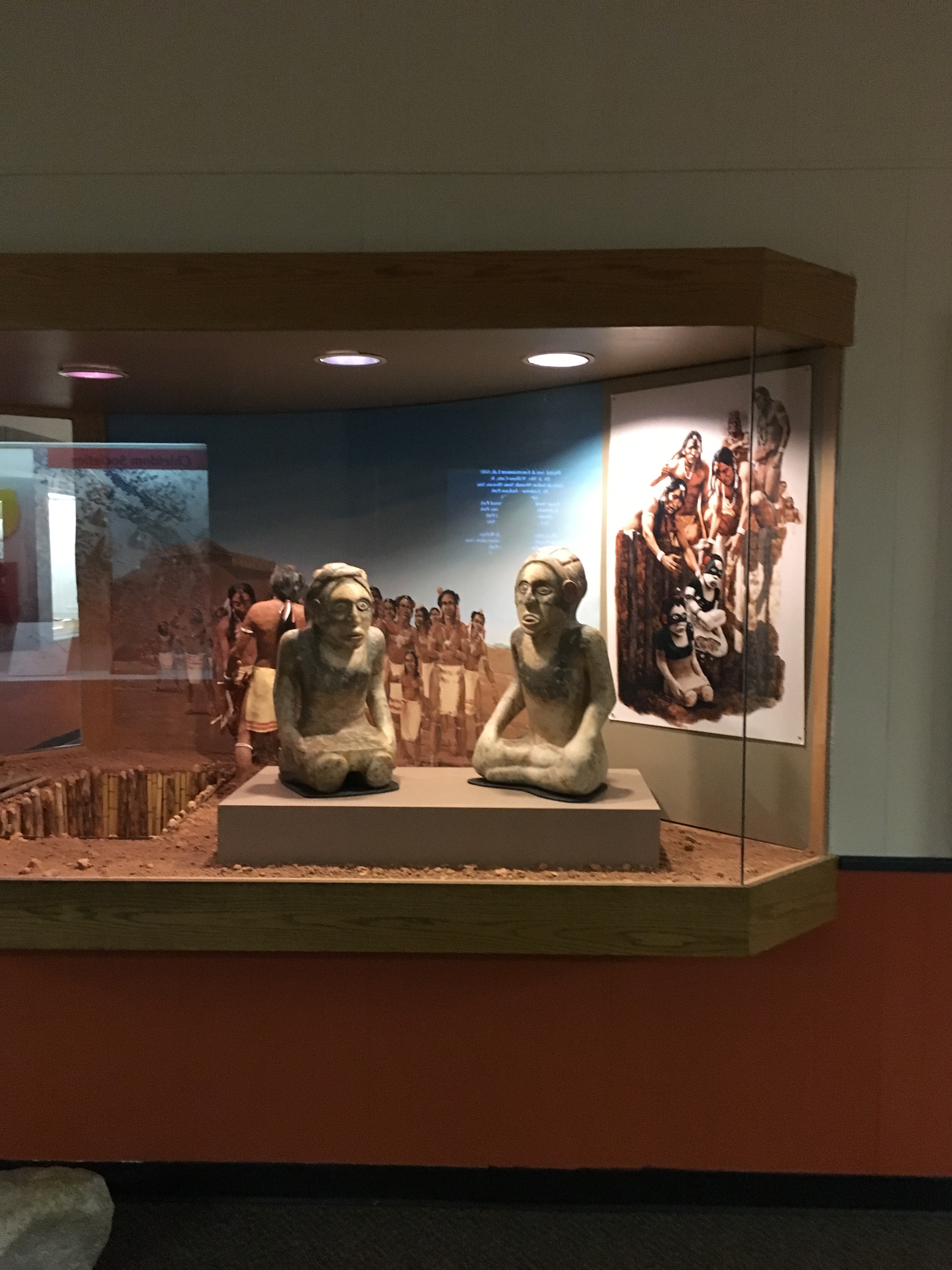
Home to several thousand Native
Americans from 1000 A.D. to 1550 A.D., this 54-acre site protects six earthen
mounds, a plaza, village site, borrow pits and defensive ditch. Etowah Mounds is
the most intact Mississippian Culture site in the Southeast and is from the same
Mississippian Tribe that built the Cahokian Mounds the Boys visited just east of
St. Louis on the Route 66 Tour.
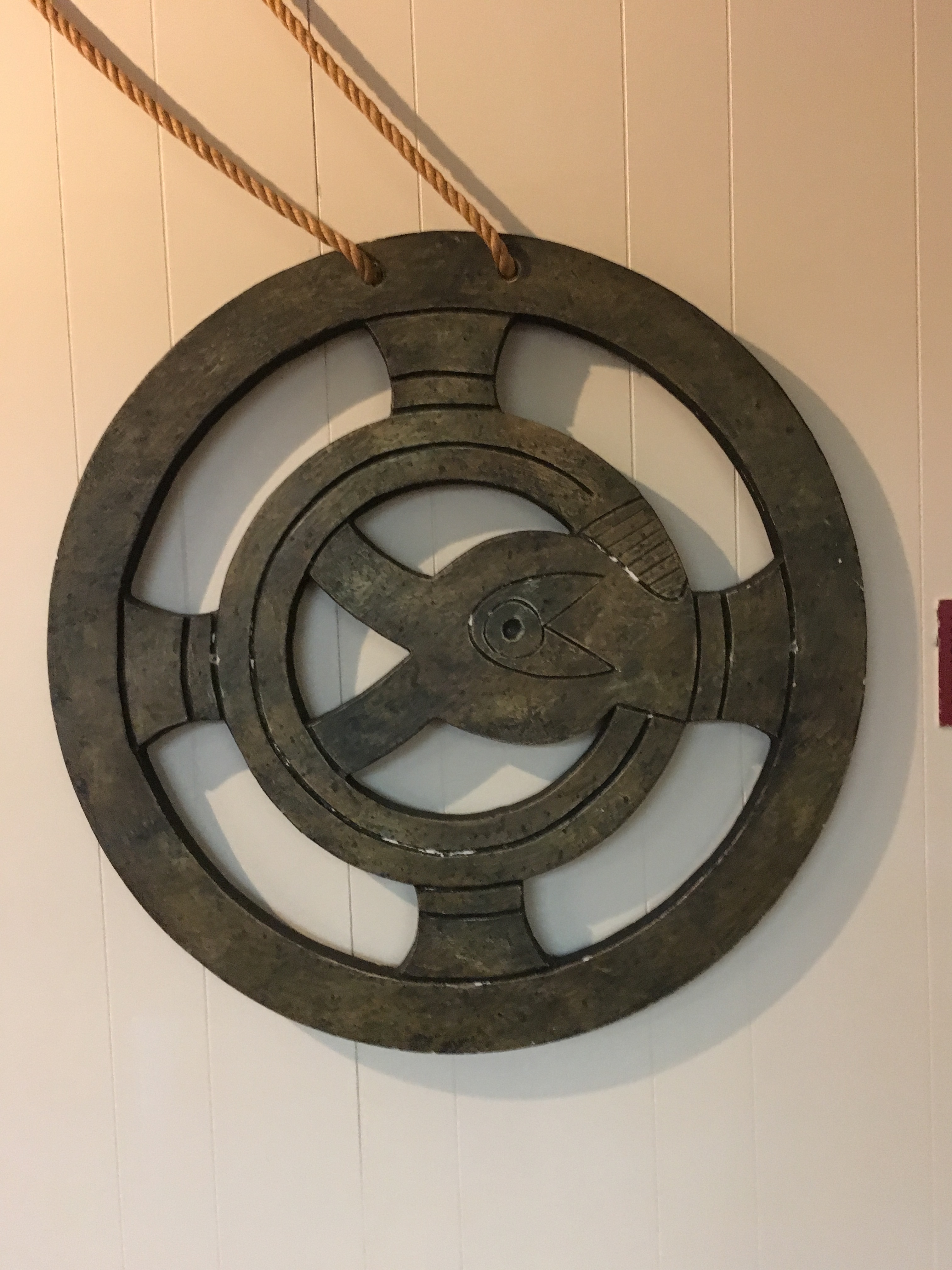
While only nine percent of this site
has been excavated, examination at the Mounds and surrounding artifacts revealed
much about the people who lived here. They were a society rich in ritual.
Towering over the community, the 63-foot earthen knoll was likely used as a
platform for the home of the priest-chief. In another mound, nobility were
buried in elaborate costumes accompanied by items they would need in their
after-lives.
Diggin' into De Soto at Etowah

As the archeologist dug up artifacts
they came across a number a Spanish artifacts from around 1540, which
corroborated Hernando De Soto's journals of his bloody and savage pillaging and
raping he and his Spanish Conquistadors did through the Southeast.
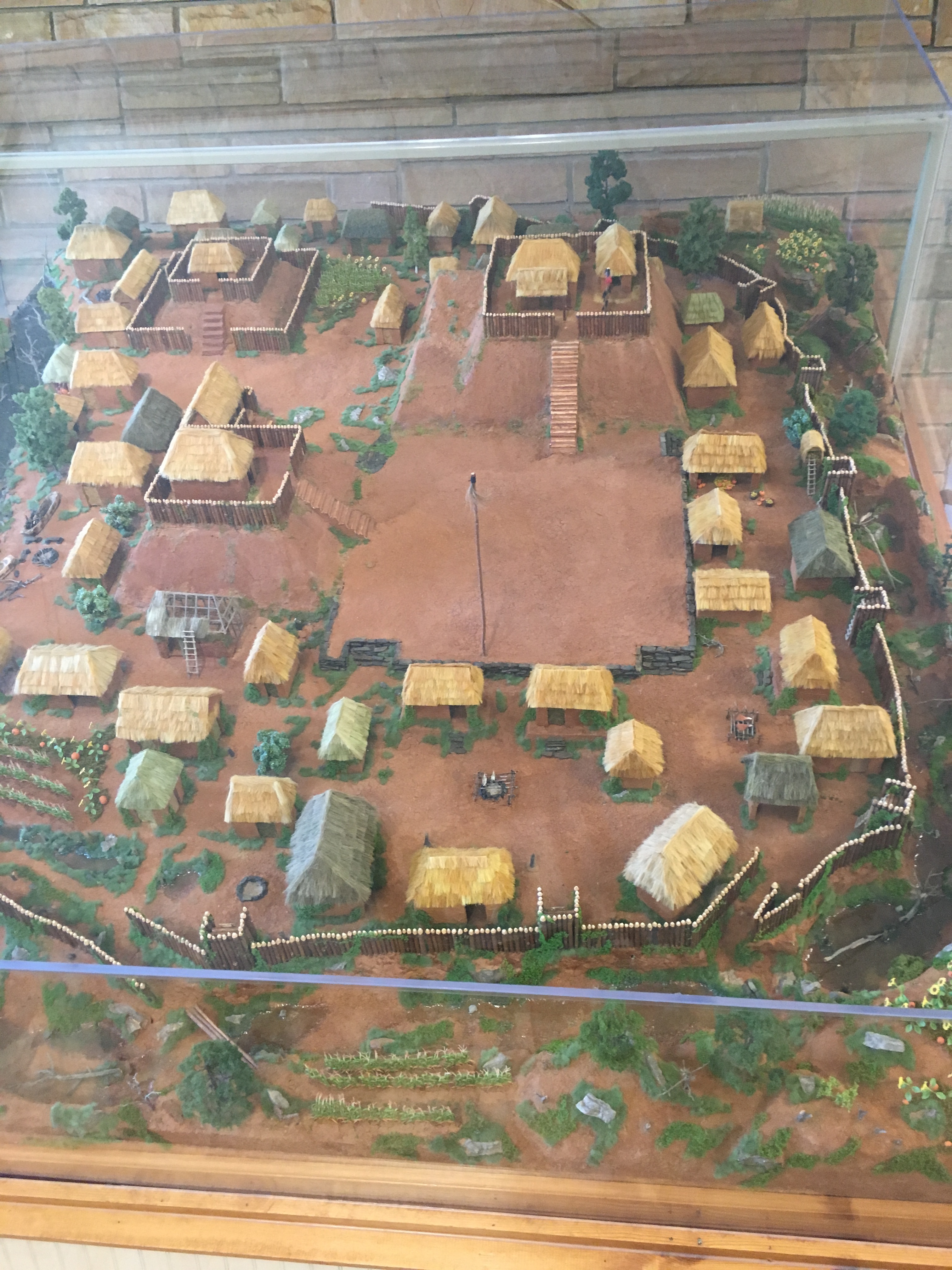
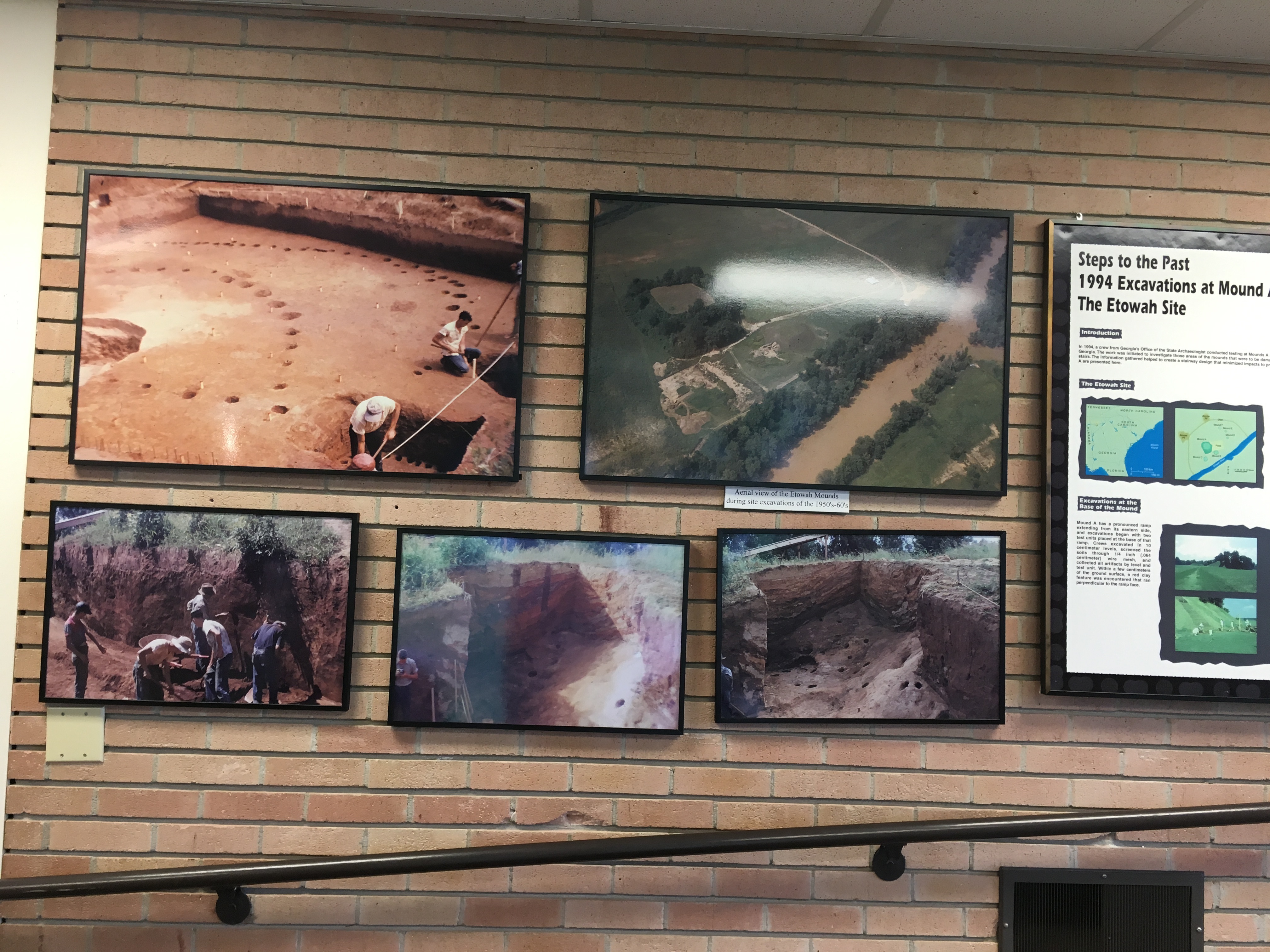
Mike and Bone stayed in the Museum and checked out the exhibits while it poured
outside. Once it slowed to a drizzle, Mike and Bone headed out to check out the
Mounds. Home to several thousand Native Americans from 1000 A.D. to 1550 A.D.,
the 54-acre site protects six earthen mounds, a plaza, village site, borrow pits
and defensive ditch.
Visitors can follow a nature trail along the Etowah River where they can
view a v-shaped fish trap used for catching fish. The trail also highlights how
early civilizations used native trees for food and medicine. Towering over the
community, the 63-foot earthen knoll was likely used as a platform for the home
of the priest-chief. In another mound, nobility were buried in elaborate
costumes accompanied by items they would need in their after-lives. the mounds
were built and occupied by prehistoric indigenous peoples of the South
Appalachian Mississippian culture (a regional variation of the Mississippian
culture) of eastern North America. They were ancestors of the historic Muskogean
language-speaking Muscogee (Creek) people who later emerged in the area. Etowah
is a Muskogee word derived from italwa meaning "town". The federally recognized
Muscogee (Creek) Nation and Poarch Band of Creek Indians consider Etalwa to be
their most important ancestral town. From 1000–1550 CE, Etowah was occupied by a
series of cycling chiefdoms over the course of five and a half centuries.
Finding Joy in the Mounds!
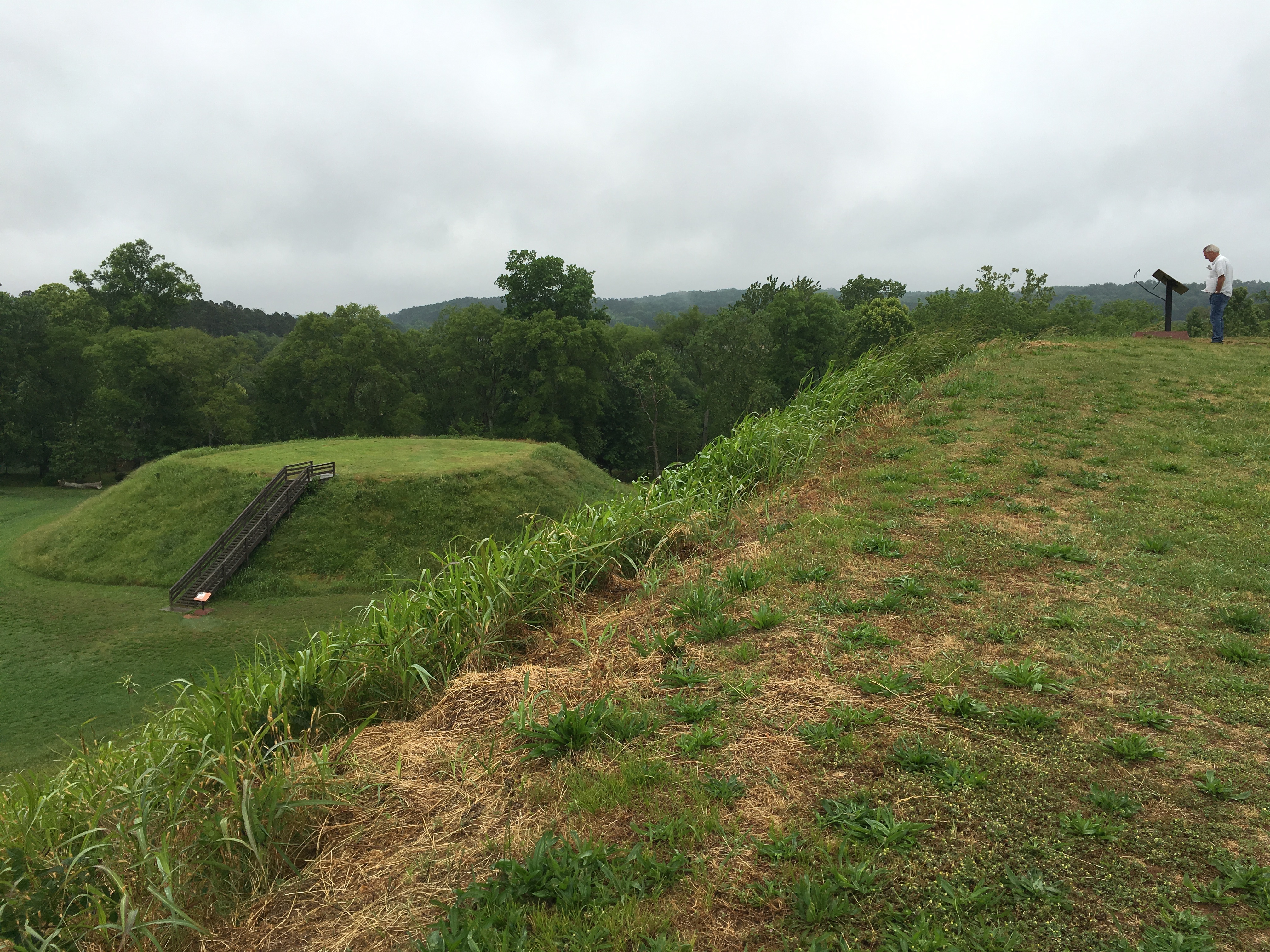
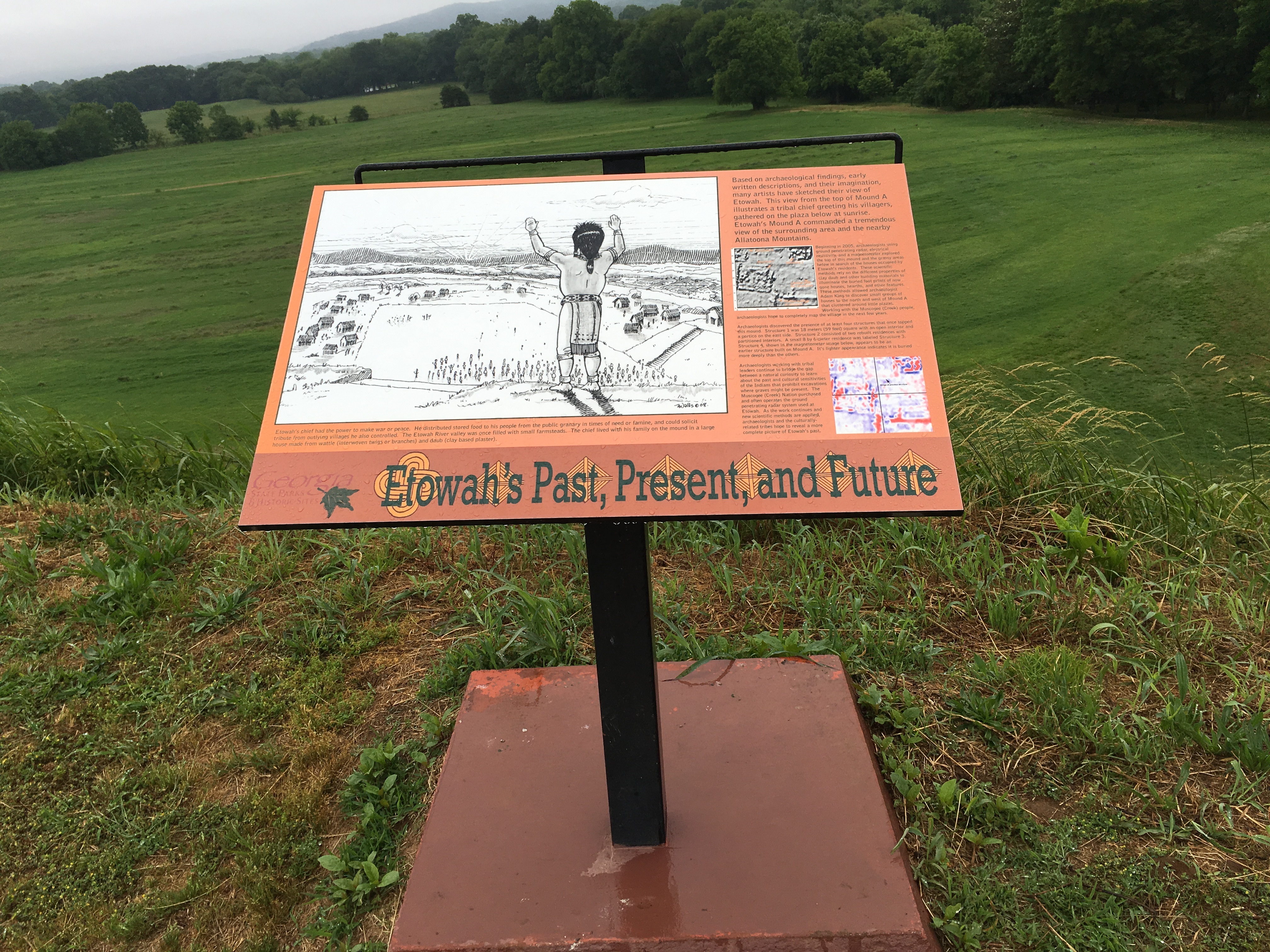
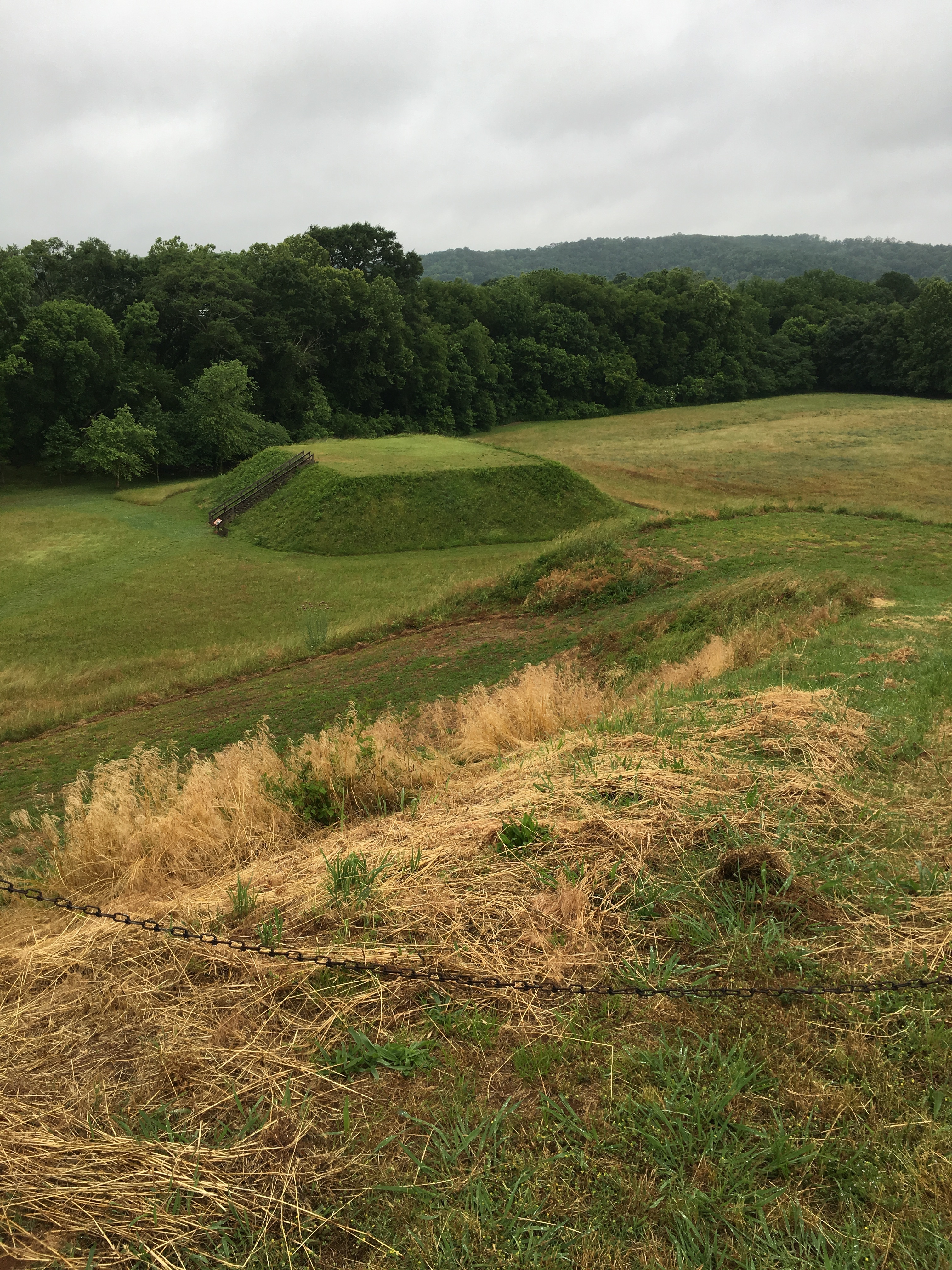
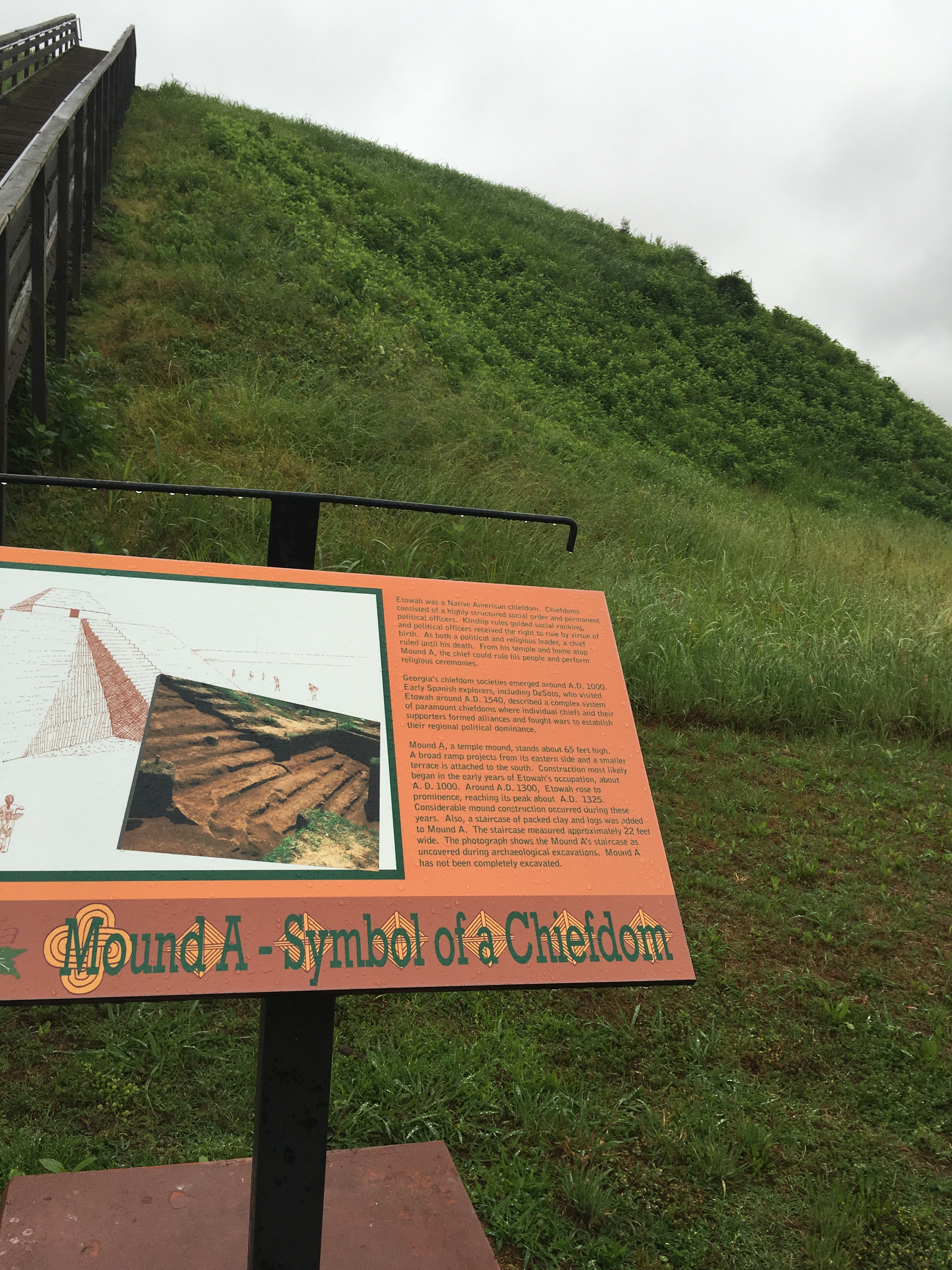
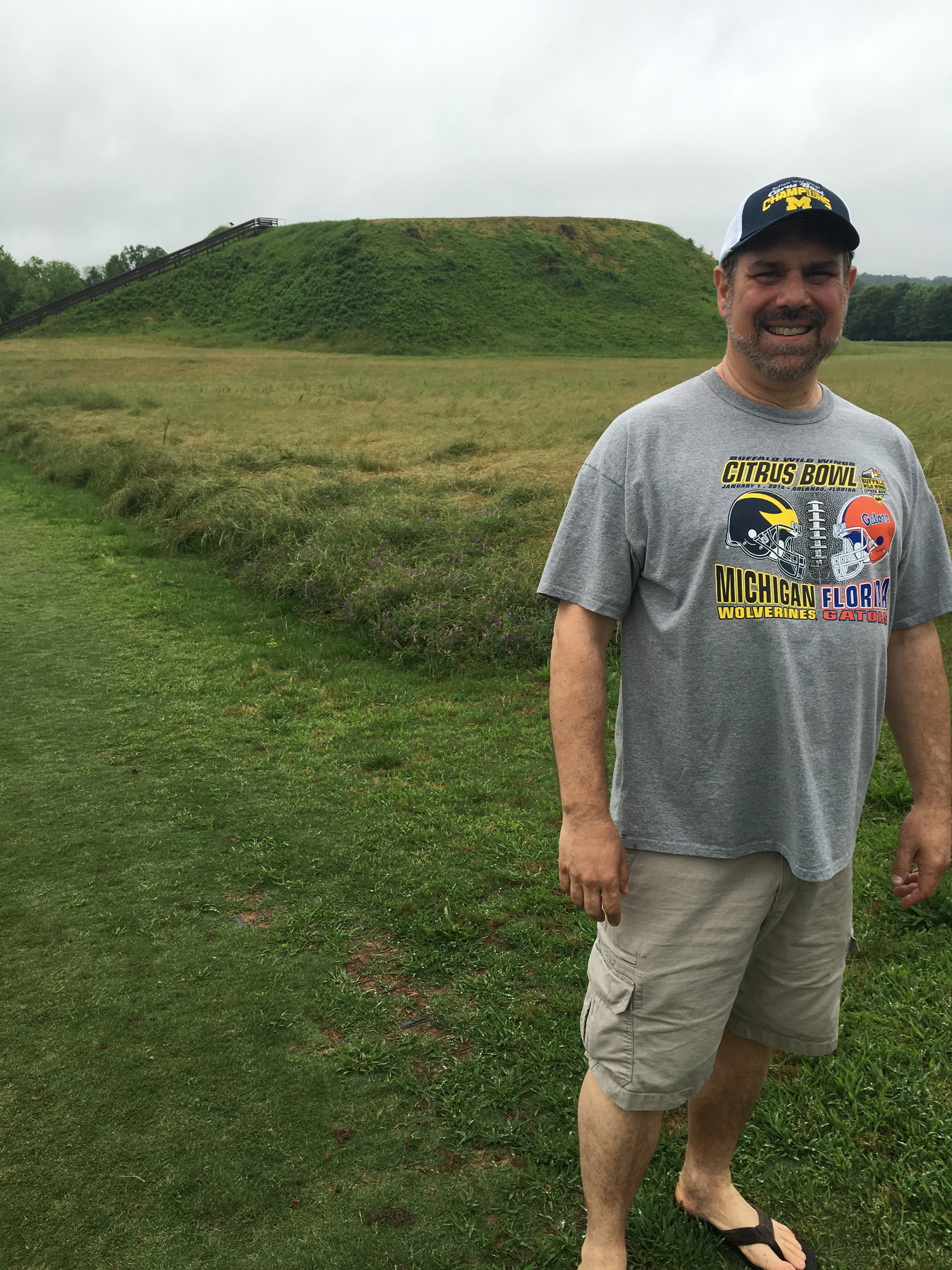
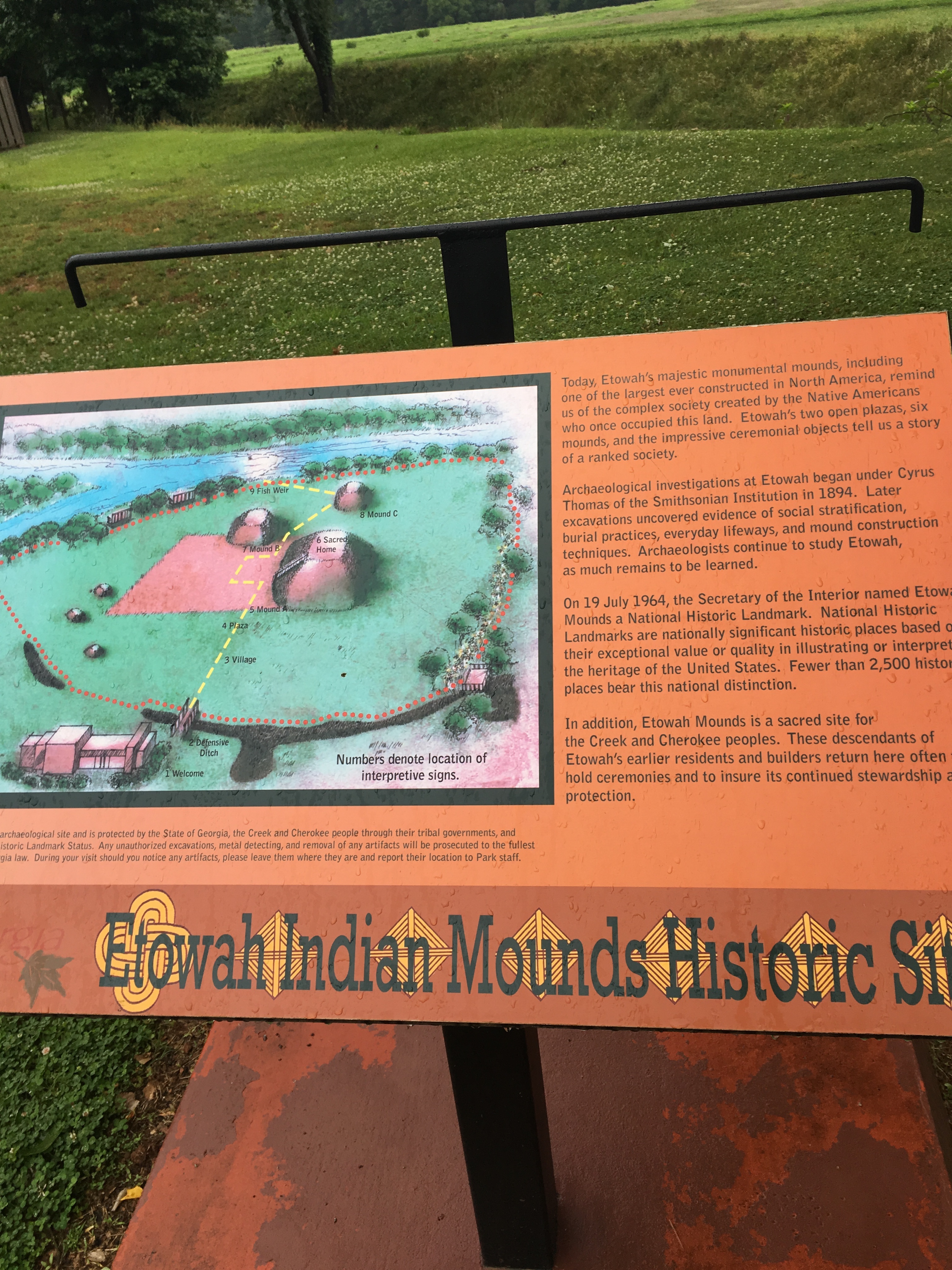
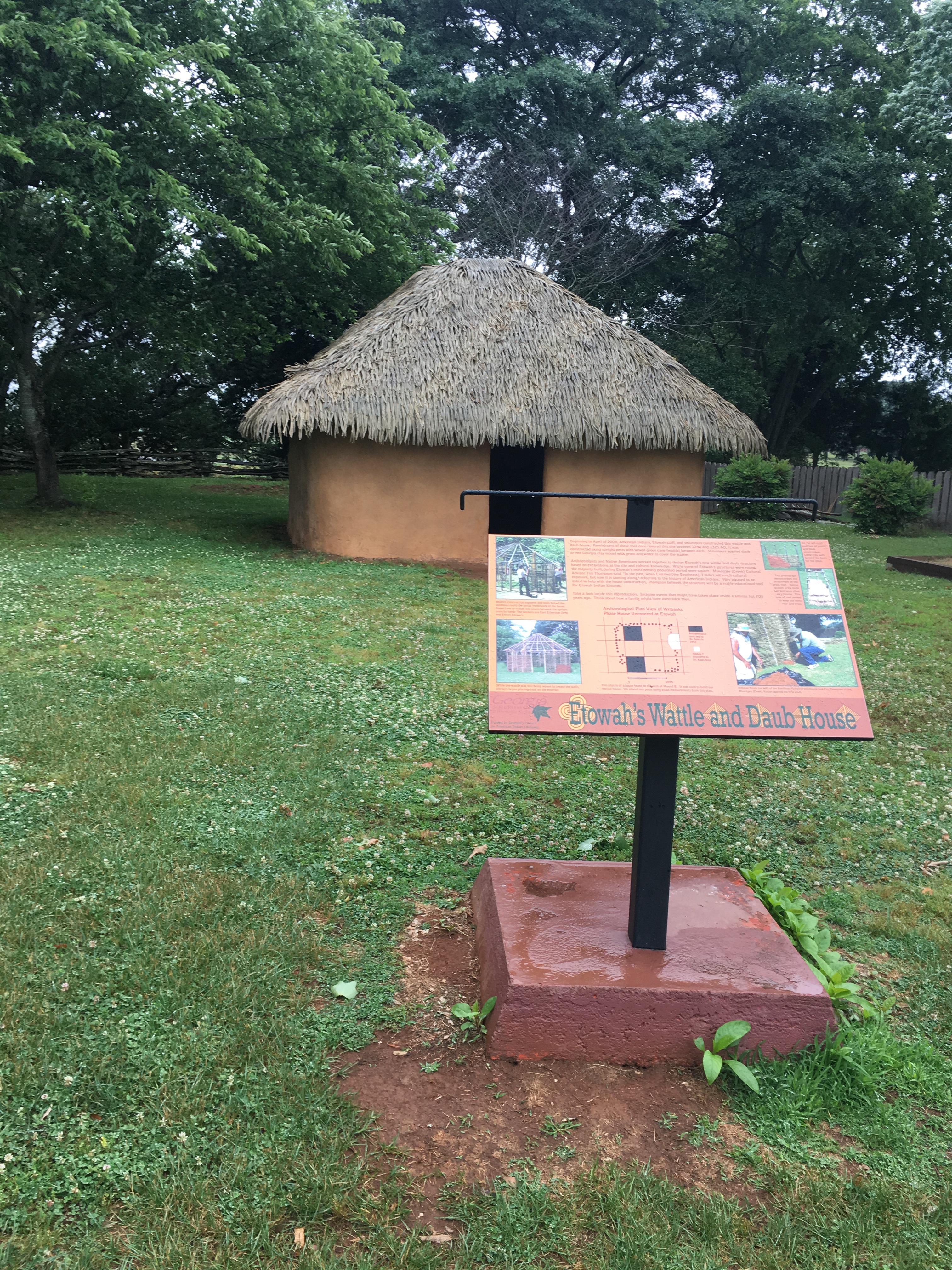
Climbing them, Mike and Bone realized what an amazing effort it must have been
without modern tools to build these mounds, Now back to the regularly scheduled
Civil War Tour!!
Stop 5: New Hope Church (May 25 - 26)
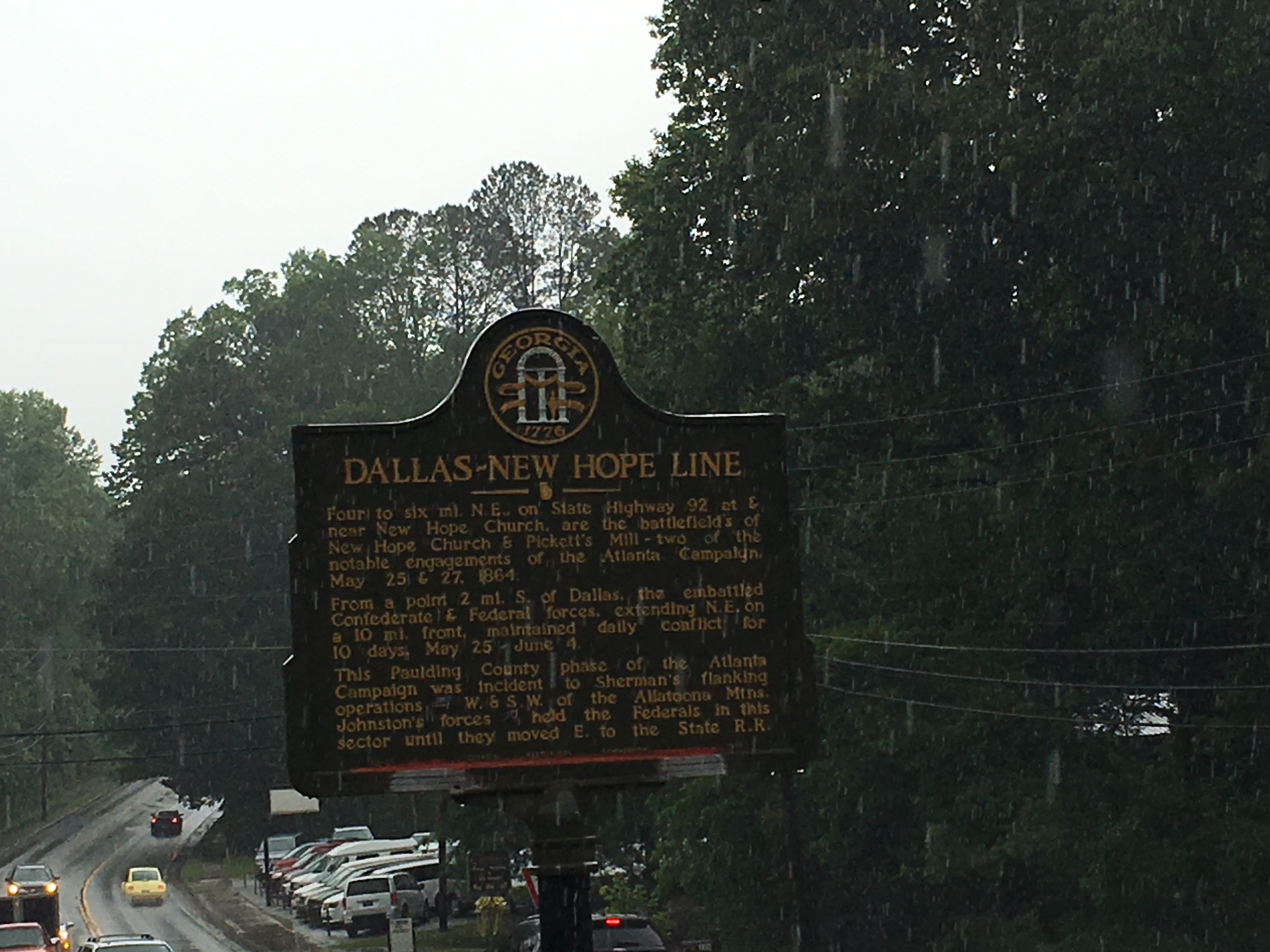
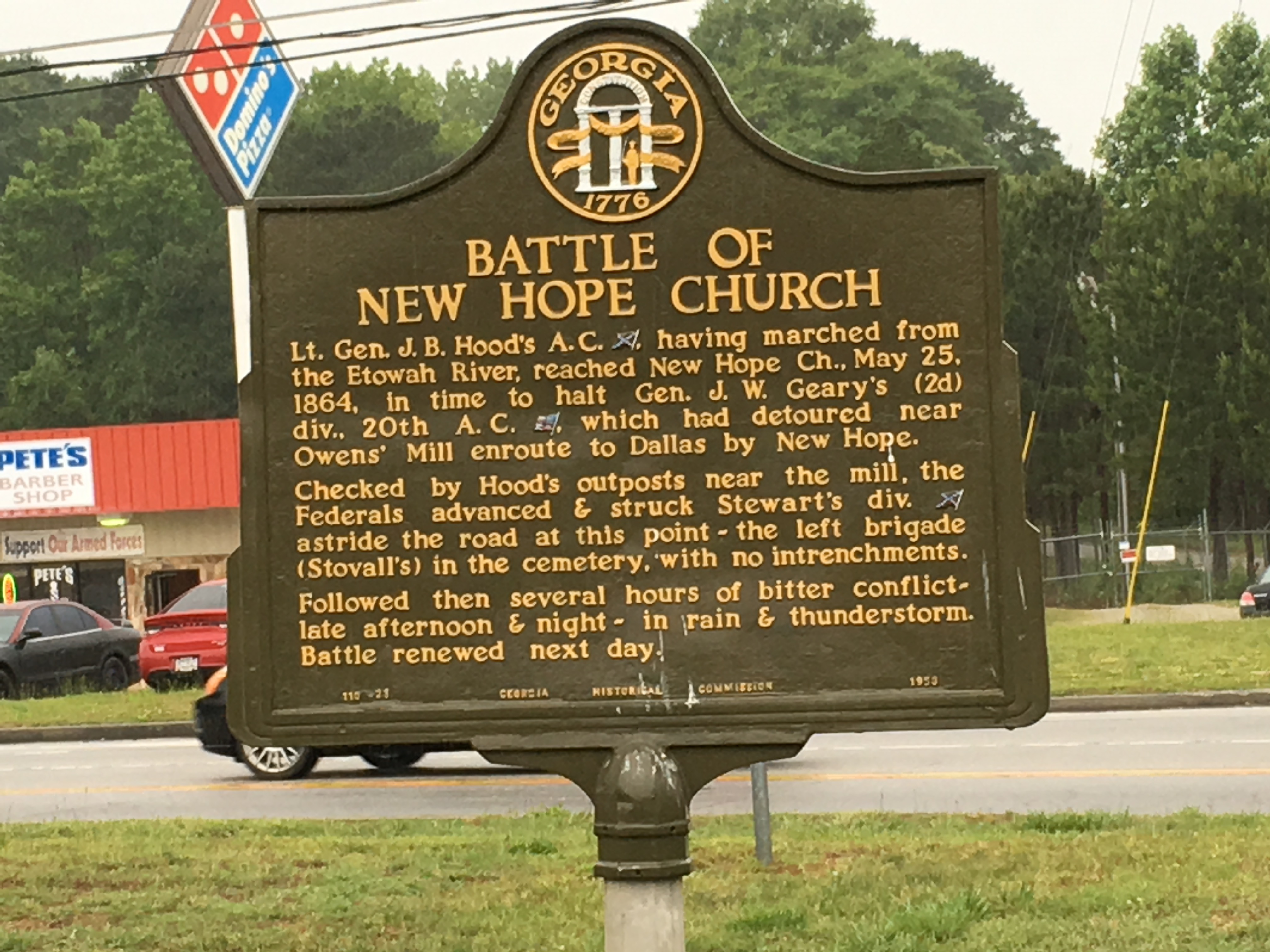
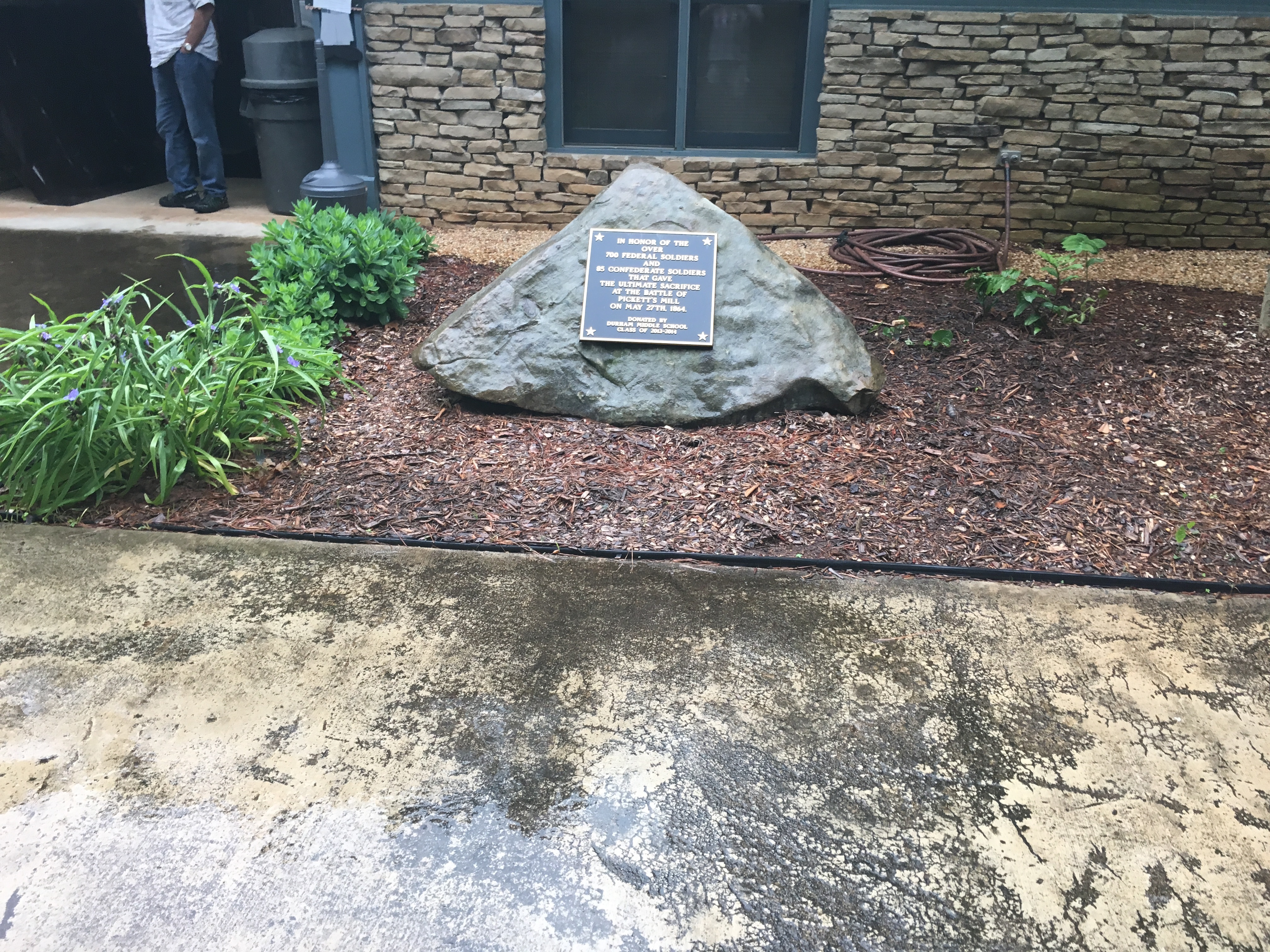
The New Hope Church Battle Site was ironically in ..... a Church Parking Lot! It
was simply a Historical marker where Johnston retreated to from Allatoona Pass
on May 19 to May 20, Sherman
decided that attacking Johnston there would be too costly, so he determined to
move around Johnston's left flank and steal a march toward Dallas. Johnston
anticipated Sherman's move and met the Union forces at New Hope Church. Sherman
mistakenly surmised that Johnston had a token force and ordered Hooker's XX
Corps to attack. This corps was severely mauled. On May 26, both sides
entrenched. Reading the signs in the continuing rain, the Boys decided that it
was time for lunch (it was pushing 2:00 PM!) and stopped for some greasy
chicken at a Southeastern Chicken Chain named after Sammy Davis Jr. Mr.
Bojangles! Then on to Dallas! (Georgia)
Stop 6: Dallas (May 26 - June 1)
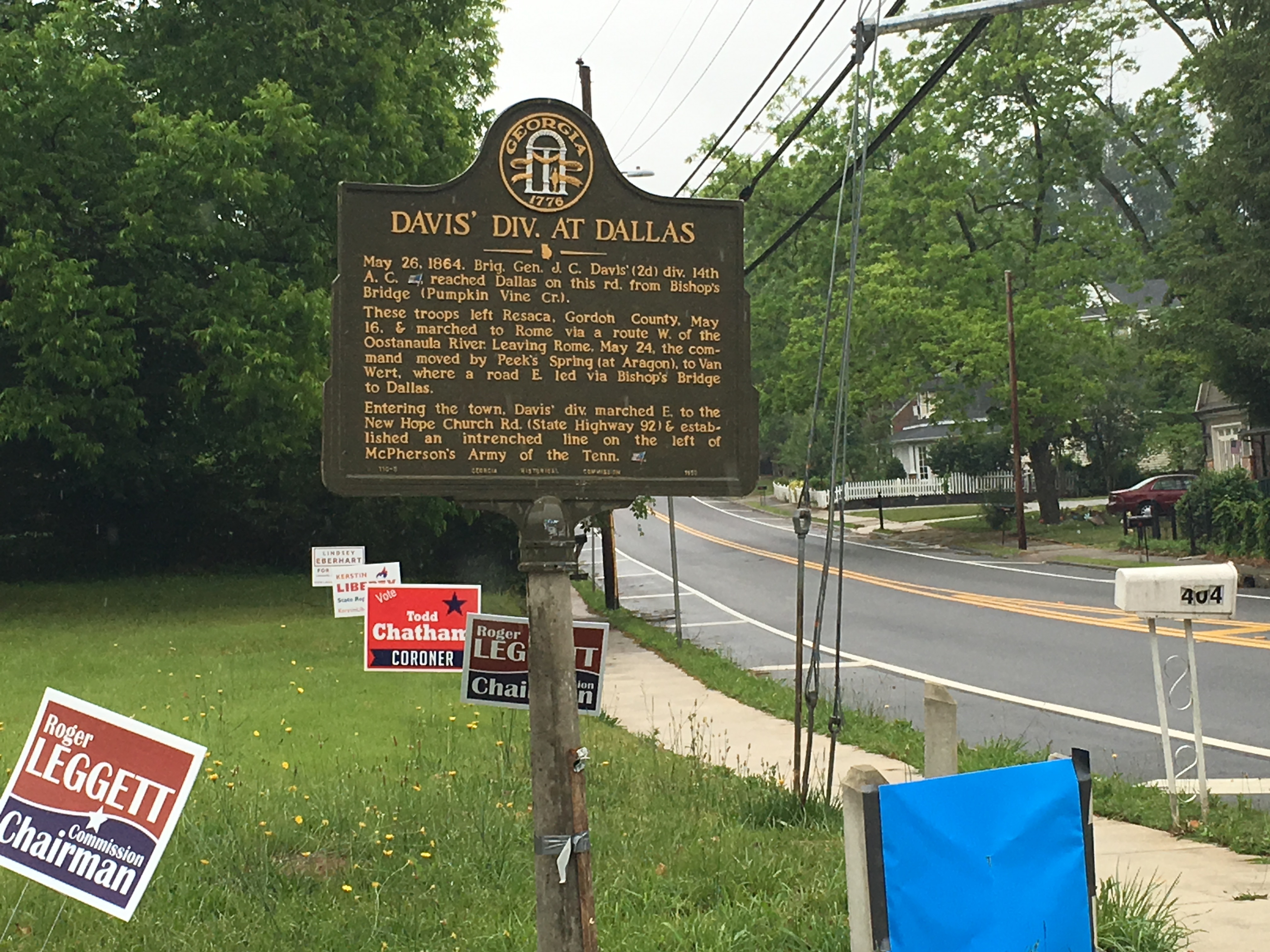
Arriving 15 minutes later the Boys found another Historical Marker site only,
where
Sherman's army tested the Confederate line. On May 28, Confederate General Hardee's
Corps probed the
Union defensive line, held by Logan's XV Corps, to exploit any weakness or
possible withdrawal. Fighting ensued at two different points, but the
Confederates were repulsed, suffering high casualties. Sherman continued looking
for a way around Johnston's line, and on June 1, his cavalry occupied Allatoona
Pass, which had a railroad and would allow his men and supplies to reach him by
train. Sherman abandoned his lines at Dallas on June 5 and moved toward the
railhead at Allatoona Pass, forcing Johnston to follow soon afterward.
Stop 7: The Battle of Pickett's Mill (May 27)
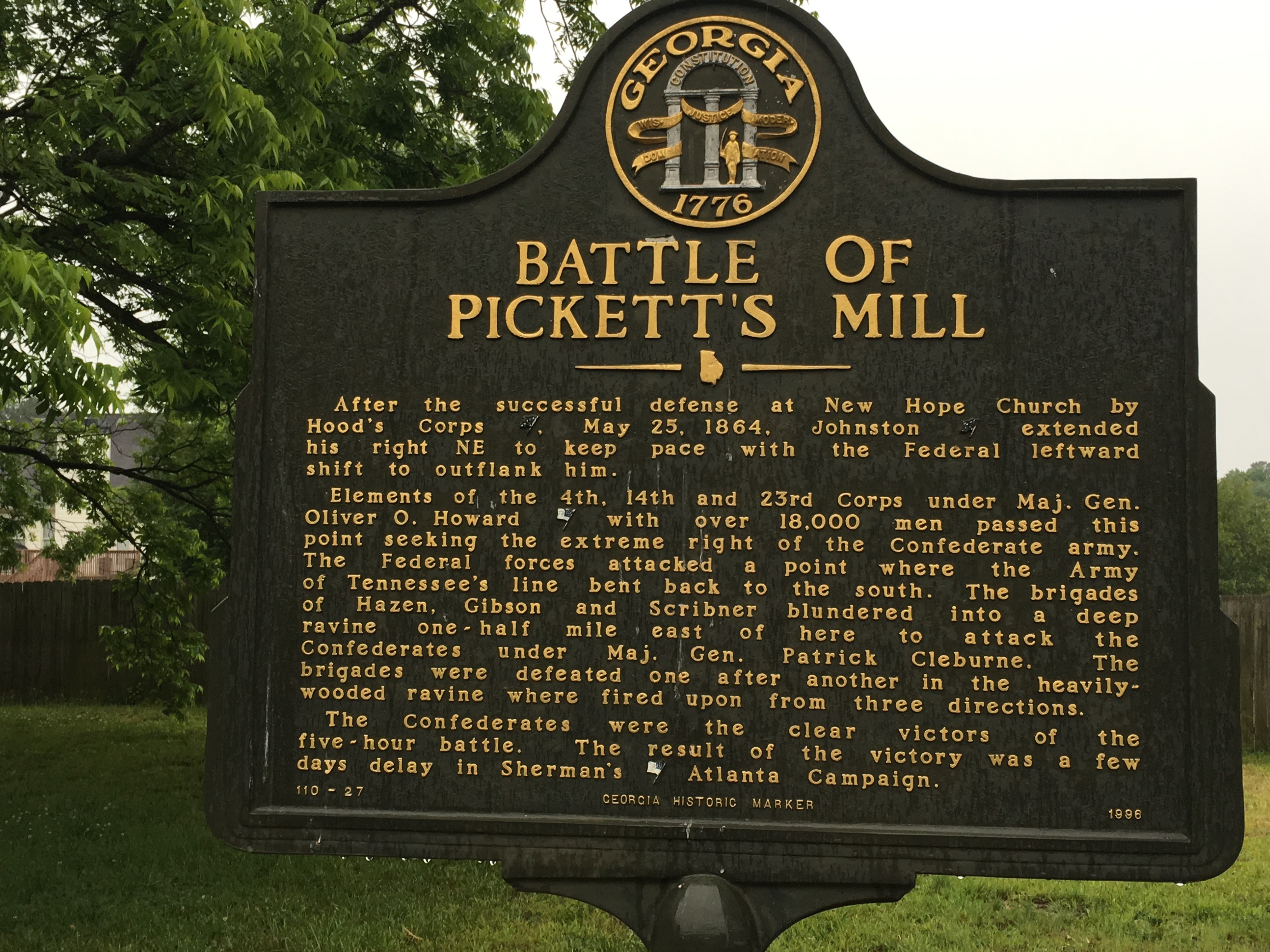
By now it was pushing 4:30 and the rain was really
coming down. Mike and Bone drove to the next battle which turned out to be a
full Georgia State Park, complete with Visitor Center! The Boys just got there
before they were going to lock up for the night, they would not let them walk
the Battlefield, but talk to them for about 15 minutes on what the Battle was
all about. After the Union defeat at New Hope Church, Sherman
ordered General Oliver. O. Howard to attack Johnston's seemingly exposed right flank. The
Confederates were ready for the attack, which did not unfold as planned because
supporting troops never appeared. At the same time Howard, who was known to not
be an aggressive general, slowly "fed" his troops into the battle, so rather
than overwhelming the Rebels, he fought down to their troop levels, letting the Confederates repulsed the attack, causing
high casualties. After chatting with the Park Rangers, Mike and Bone considered
a illicit run to check out the Battlefield, but the gloom and downpour dissuaded
the intrepid duo. So back on the Highway 41 heading south to Kolb's Farms.
Stop 8: Battle of Kolb's Farm (May 22)
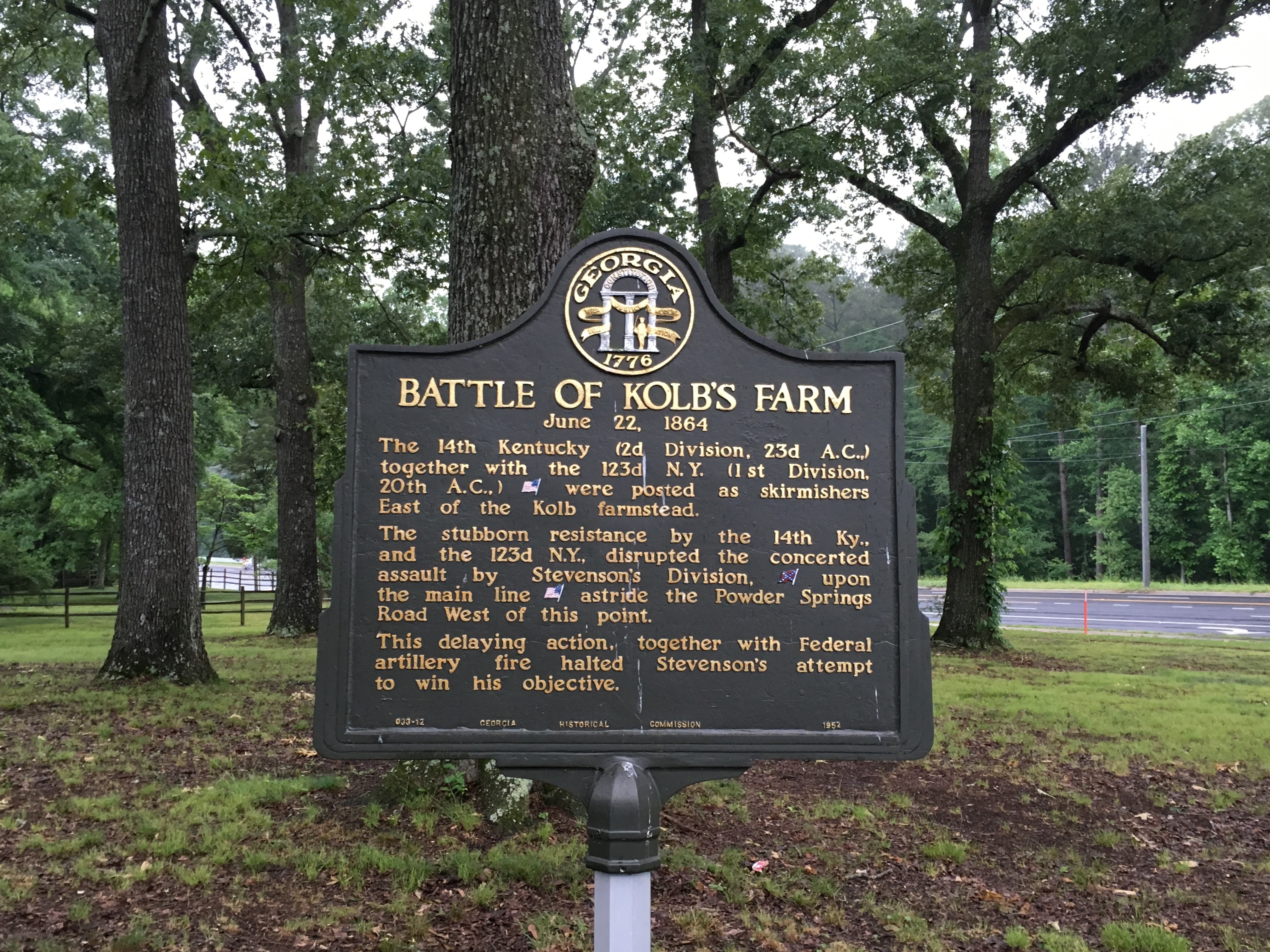
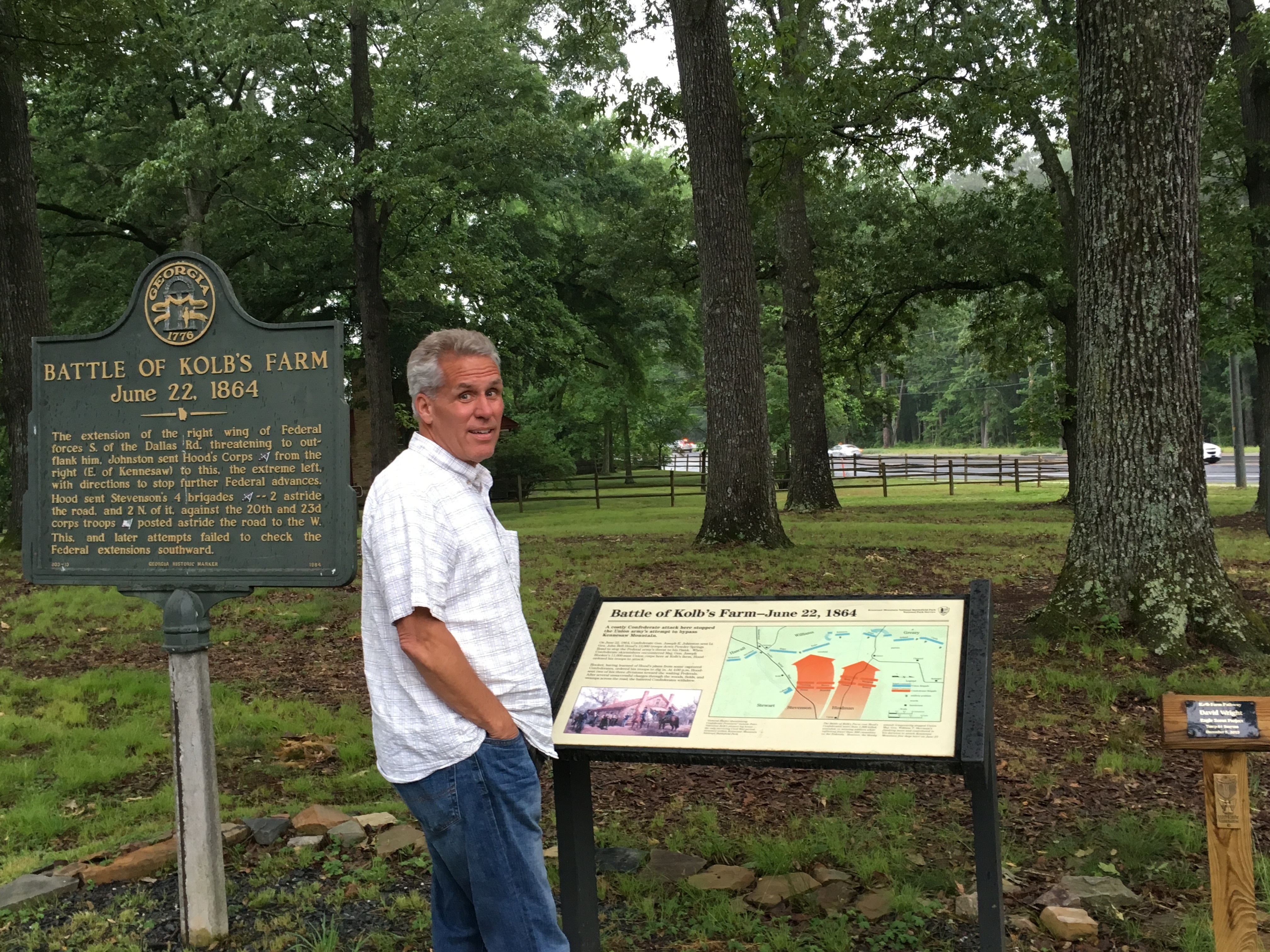
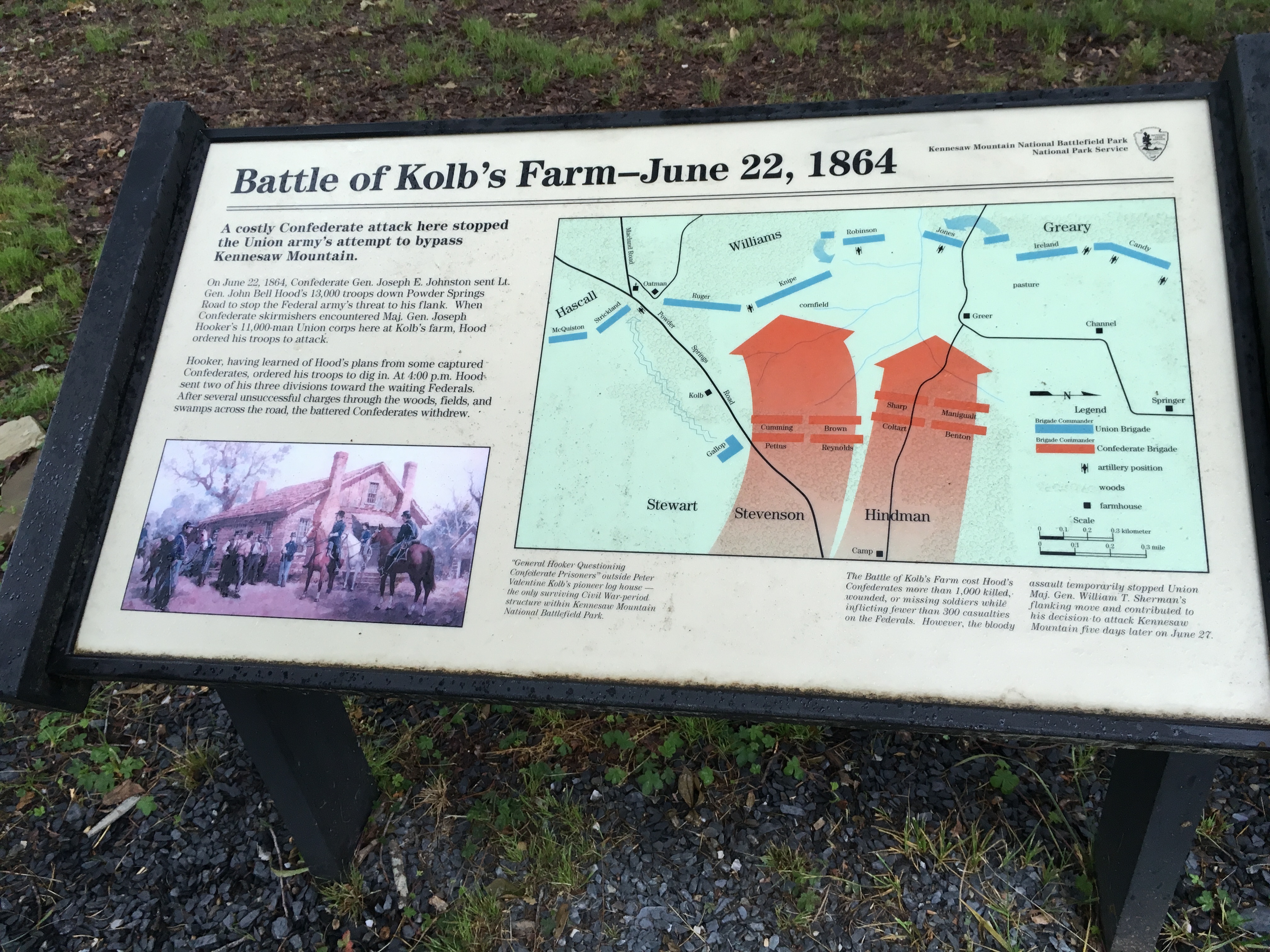
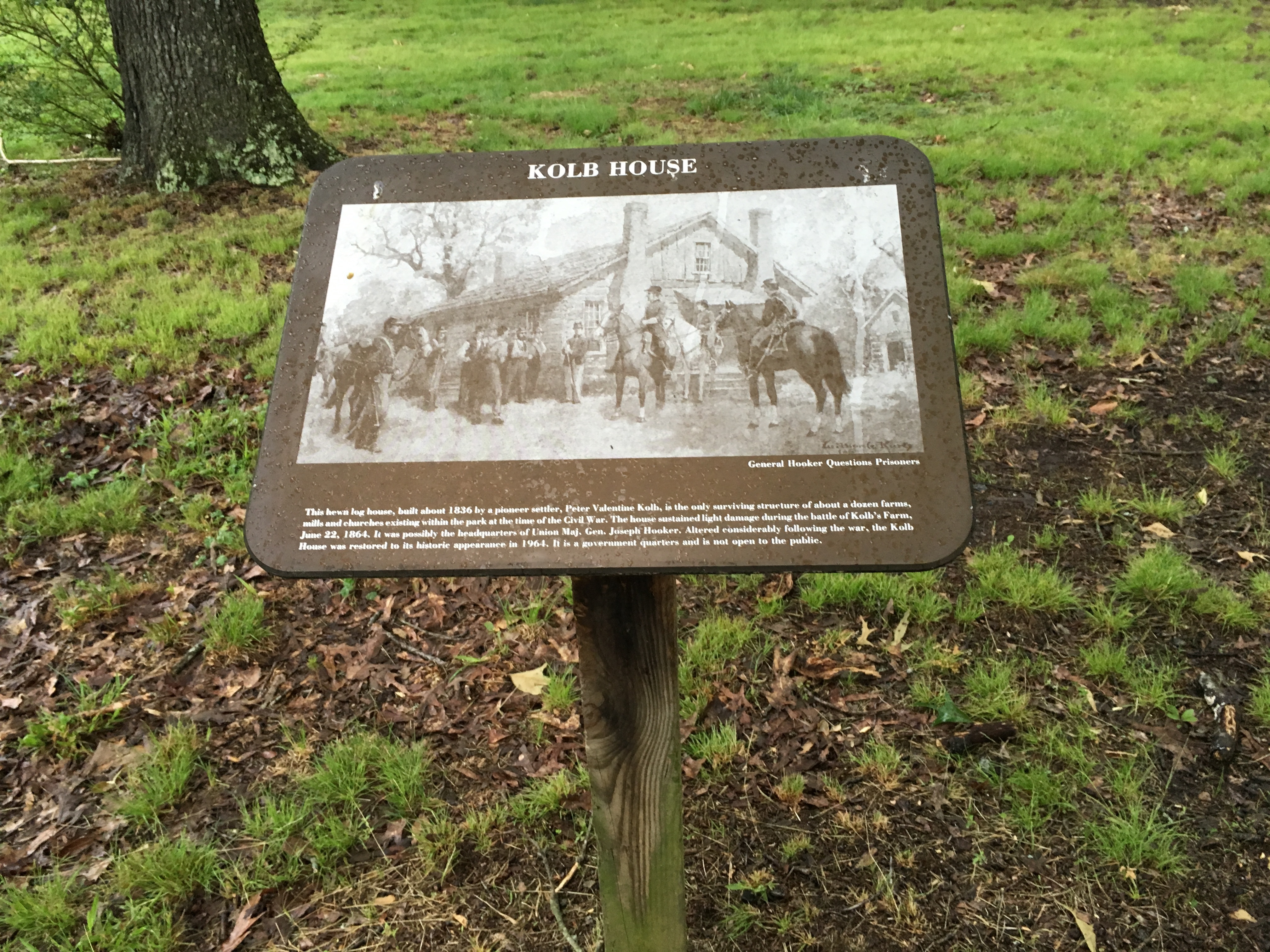
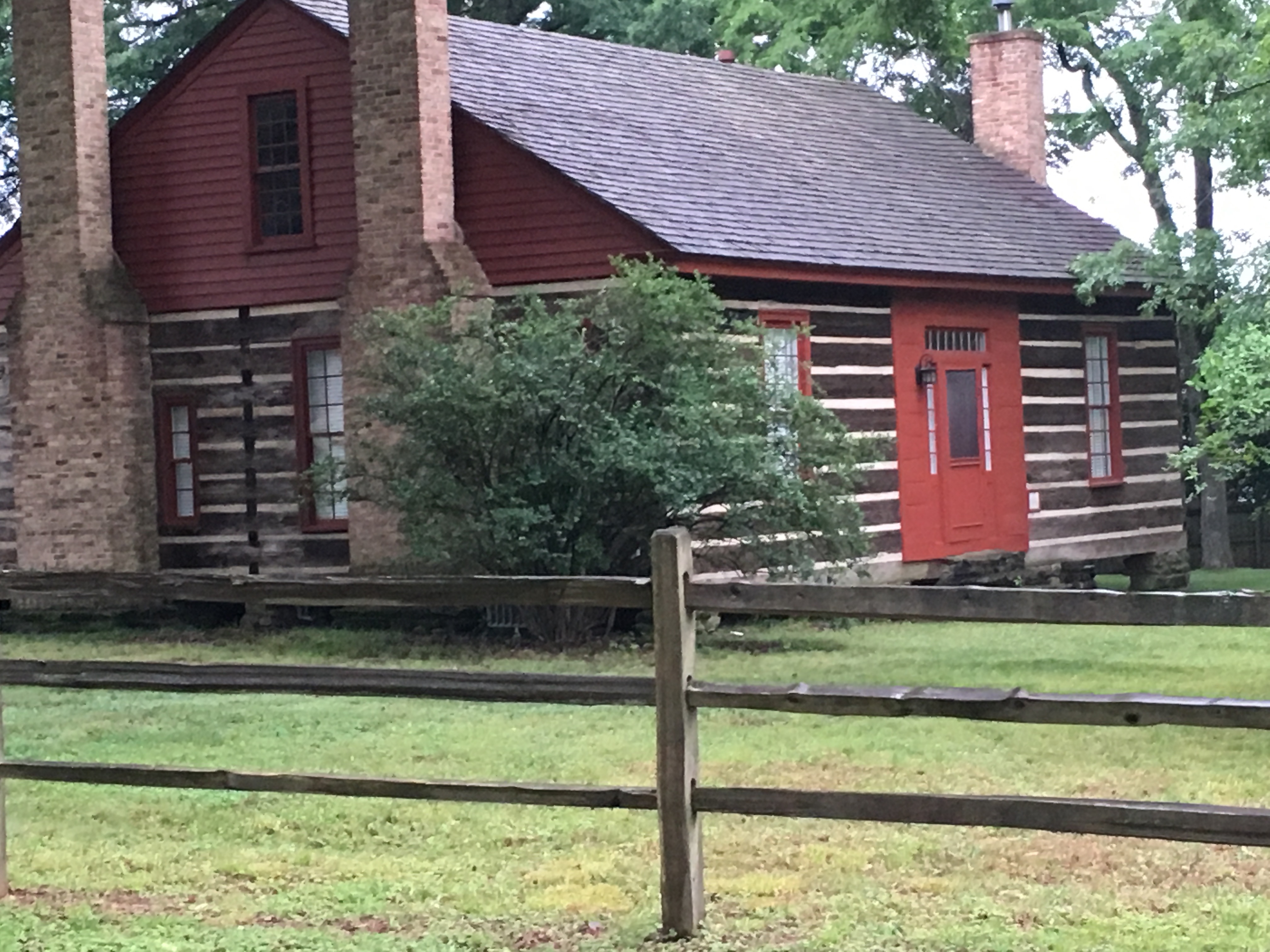
Mike and Bone found
Kolb's Farm outside of Kennesaw Mountain National Park, which was
exactly halfway on the Atlanta Campaign. Where
having encountered entrenched Confederates astride
Kennesaw Mountain stretching southward, Sherman fixed them in front and extended
his right wing to envelop their flank and menace the railroad. Johnston
countered by moving Hood's corps from the left flank to the right on June 22.
Arriving in his new position at Mt. Zion Church, Hood decided on his own to
attack. Warned of Hood's intentions, Union generals John Schofield and Joseph
Hooker entrenched. Union artillery and swampy terrain thwarted Hood's attack and
forced him to withdraw with heavy casualties. Although he was the victor,
Sherman's attempts at envelopment had momentarily failed.
Mike and Bone checked out the farm and decided it
was time like the Federals for Operations around Marrietta.
Operations around Marietta (June 9 – July 3)
When Sherman first found Johnston entrenched in the Marietta area on June 9, he
began extending his lines beyond the Confederate lines, causing some Confederate
withdrawal to new positions. On June 14, Lt. Gen. Leonidas Polk was killed by an
artillery shell while scouting enemy positions with Hardee and Johnston and was
temporarily replaced by Maj. Gen. William W. Loring. On June 18–19, Johnston,
fearing envelopment, moved his army to a new, previously selected position
astride Kennesaw Mountain, an entrenched arc-shaped line to the west of
Marietta, to protect his supply line, the Western & Atlantic Railroad. Sherman
made some unsuccessful attacks on this position but eventually extended the line
on his right and forced Johnston to withdraw from the Marietta area on July 2–3.
It was from here, the biggest battle of the Atlanta Campaign was to commence,
But first, Mike and Bone had to forage for some victuals! Namely checken wings
and beer!
Foraging for Sustenance: Marauding Marietta with the Houghton's!
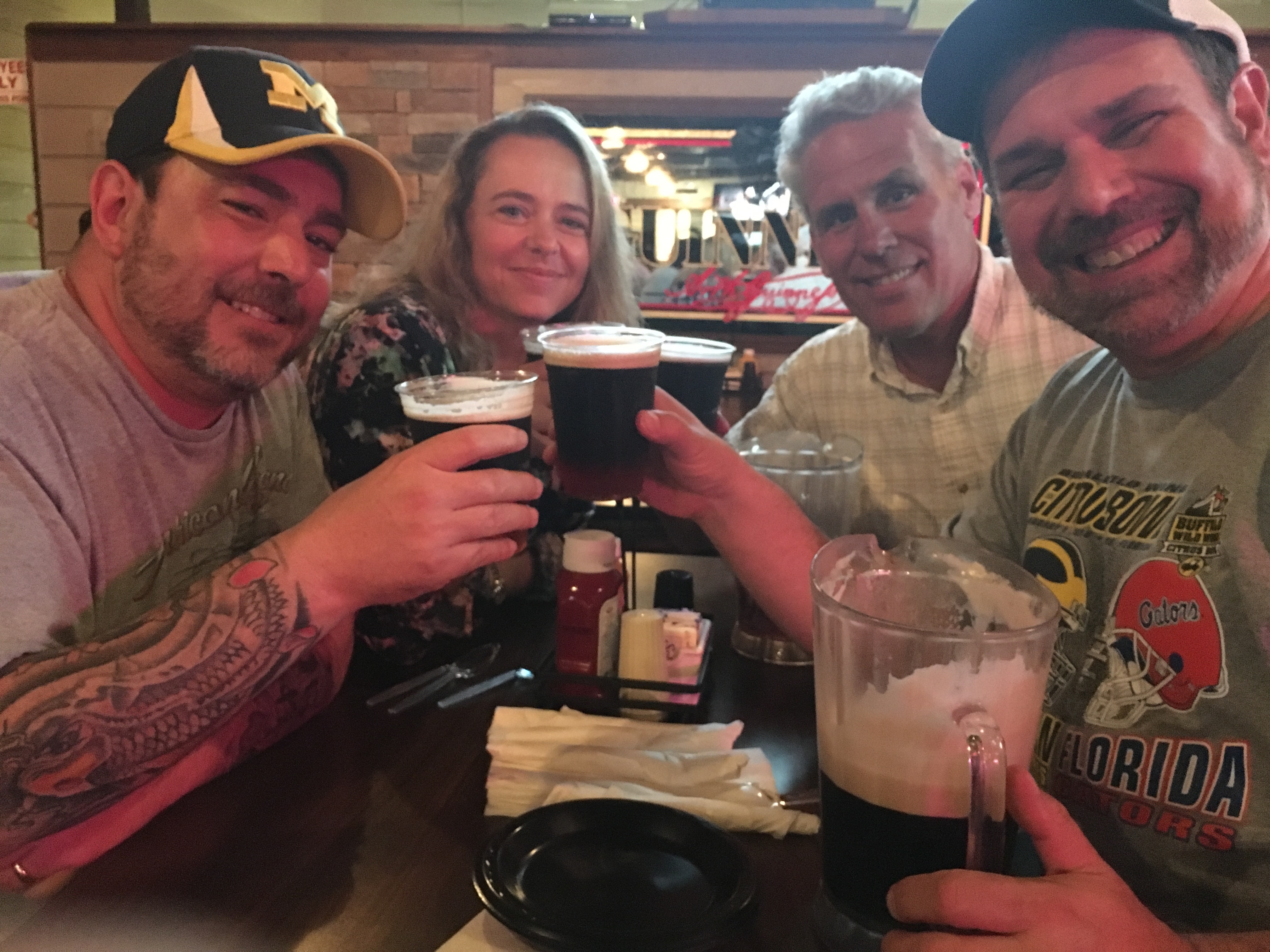
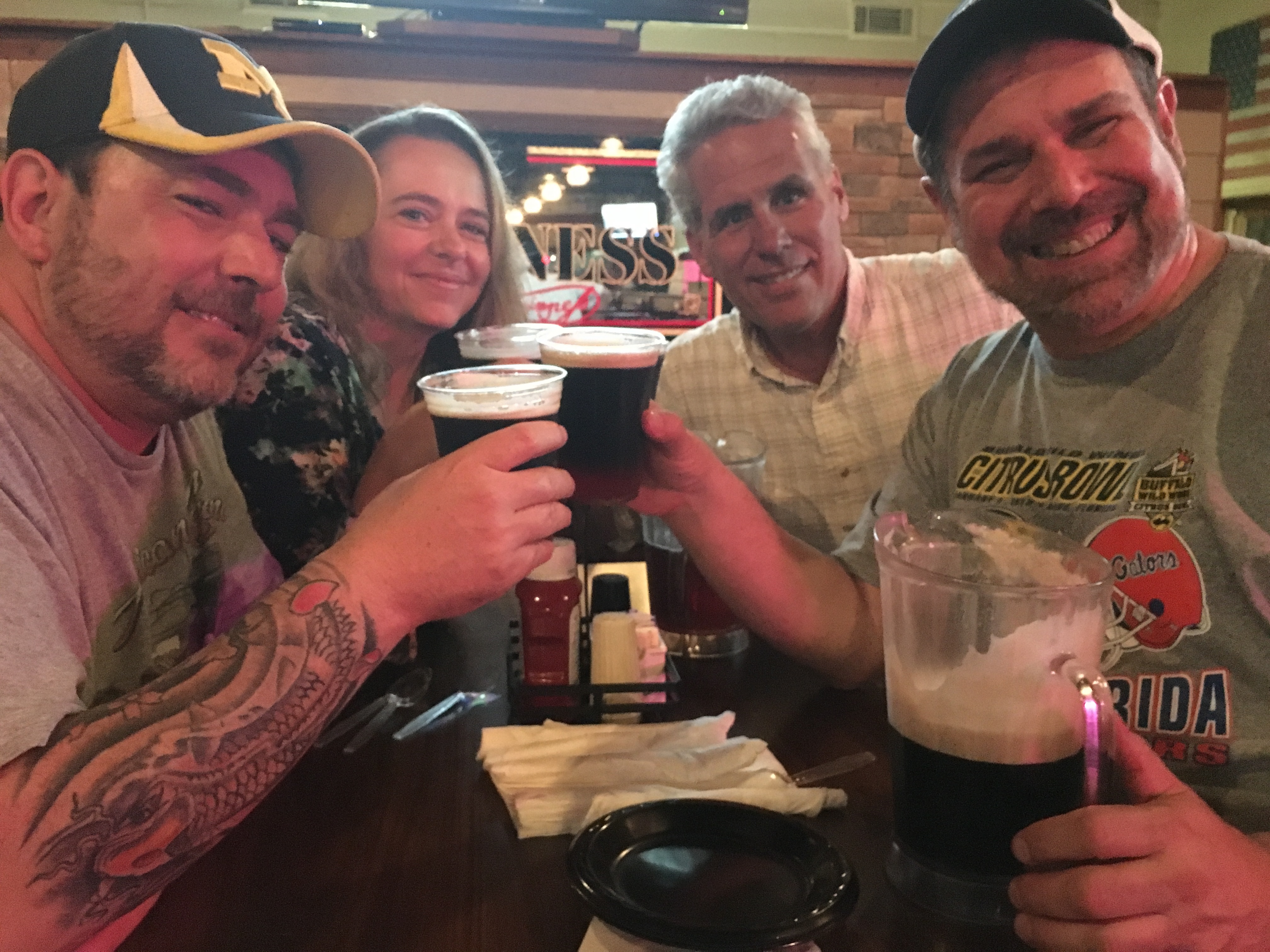
Downtown Marrietta is a lovely
little Square with cool little shops in the area. Fortunately Bone knew of a
couple of Union Sympathizers from the Greater Boston area, Jay and Jen Houghton!
Bone had worked with Jay at IBM, Merkle, and then IBM again. Being of the Irish
persuasion the Guinness and Bushmill not in just one Irish Pub, but two till the
wee hour of 1:00 AM, Mike and Bone dropped off the Houghton's with the delusion
of horse riding the next day and staggered into a Hilton to collapse!